#louise's first comic appearance was in 1984
Explore tagged Tumblr posts
Text

louise would excel in the winter olympics at the cost of easily becoming the most hated player. she embodies princess daisy's rage and severely lacks good sportsmanship. has beef with every rival team to ever exist because of her trash talk and would constantly use psychological tactics just to get ahead of them. she may be reckless but she's not entirely stupid. louise avoids being disqualified. loves to use this sport as a excuse to unleash her violent tendencies. doesn't cope well with failure or mistakes AT ALL. louise feels like she has to be on top of her game because it's expected of her. the U.S puts pressure into her shoulders so much it's suffocating to live up to their expectations but they love her don't they? she does it for the love of manhattan. they're going to call her queen one day.
#˗ˏˋ ༄ ──── 𝐇𝐄𝐀𝐃𝐂𝐀𝐍𝐎𝐍𝐒 〳 ❪ violence creates and molds as well ❫#her team loses: what a bunch of useless assholes!! get your shit together!!#her team wins: as all things should be...i am the backbone of this team!!#olympian AU when??#because god knows i need louise in hockey gear#or figure skating attire#100% argues with the on-ice officials because she purposely injured a rival member and denies it was a malicious act 😭😭#her number would be 85 just to reference her first appearance as KF#louise's first comic appearance was in 1984
9 notes
·
View notes
Text

Sir Dr. Lenworth George Henry CBE (August 29, 1958) is a British actor, comedian, singer, television presenter and writer.
He gained success as a stand-up comedian and impressionist in the late 1970s and early 1980s, culminating in The Lenny Henry Show in 1984. He was the most prominent Black British comedian of the time and much of his material served to celebrate and parody his African-Caribbean roots.
He co-founded the charity Comic Relief. He has appeared in numerous other TV programs, including Tiswas, Chef!, and The Magicians, and in his later years has transitioned toward acting roles on stage and screen. He appears in The Lord of the Rings: The Rings of Power.
He is the chancellor of Birmingham City University.
He was born in Dudley to Albert Augustus Green and Winifred Louise Henry who had emigrated to Britain from Jamaica. The fifth of seven children, he was the first child of the family to be born in the UK. He attended St John’s Primary School and The Blue Coat School, before completing his schooling at W.R. Tuson College.
He was asked by Sky Arts to produce Lenny Henry’s Got The Blues. He worked with a group of musicians to produce the album New Millennium Blues. The album consists of both covers of blues classics, as well as original tracks co-written by Lenny. He released a “hard-hitting animated blues video” titled The Cops Don’t Know.
He has published four books, two autobiographies, and two young adult fantasies.
He married Dawn French (1984-2010) and had one child.
He obtained a BA Hons in English Literature from the Open University an MA in Screenwriting for TV and Film and a Ph.D. In Media Arts from Royal Holloway, University of London. #africanhistory365 #africanexcellence
2 notes
·
View notes
Text
299. Various Authors - Dragon #85 (May 1984)

A pretty good issue of Dragon for D&D and AD&D players this one has a particular focus on the Cleric and has a lot of different articles on how to play clerics and roleplaying ideas for your character. Three main articles on healing and curing magic, variety for cleric abilities and tying actions to religious outlook (i.e. acting in accordance with the cleric's faith) make up this pretty good cleric section.
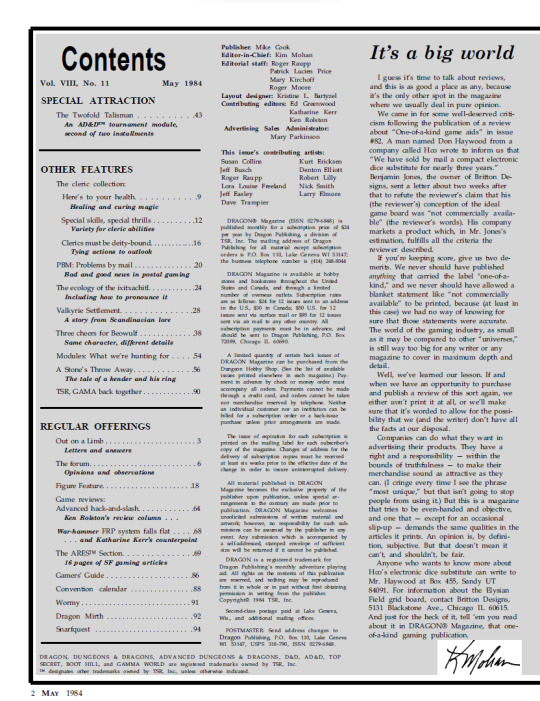
Other columns are also good, with Ed Greenwood bringing us the Ecology of the Ixitxachitl, those vampiric flying manta-rays and the second part of the Twofold Talisman adventure. One of the fiction offerings here is also important for D&D fans, particularly Dragonlance fans, with what is the first appearance of Tasslehoff Burrfoot in fiction in a tale by Roger Moore about the Kender in his usual misadventures. This time he teleports into a Magus' castle where he witnesses a summoning of the Demogorgon with disastrous effects... but not for Tas. We also get introduced to Kitiara and Strum by the end of the tale.

With some good art, such as a full page piece by Lora Louise Freeland illustrating a fiction story, and the usual comic strips (with the exception of the late lamented What's New with Phil and Dixie), this is a pretty good issue, definitely worth tracking down if you are a cleric.

2 notes
·
View notes
Text
Dick Grayson’s Nightwing suits, Part Two
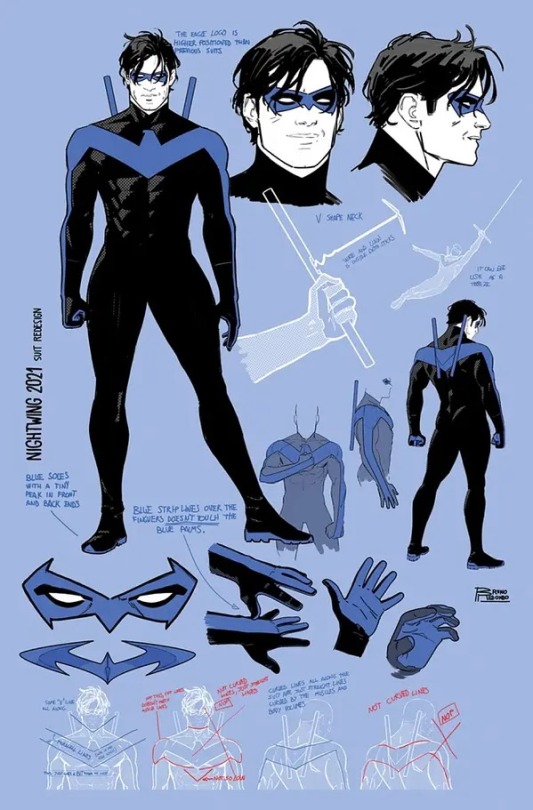
The return of the fingerstripes, design by Bruno Redondo, 2021. (First seen in Nightwing vol 4 # 88)

Dick’s original Nightwing suit in a version where he could zip up the deep v-neck and with a wrist-band firing tech. Tales of the Teen Titans Annual # 3. Writers Marv Wolfman and George Pérez, art Gorge Pérez and Dick Giordano. (1984)
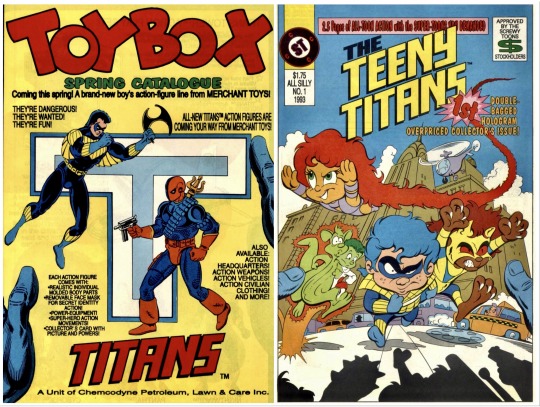
Nightwing as an action figure and in a tv and comic cartoon. New Titans # 93. Writer Marv Wolfman, art Tom Grummett, Adam Hughes and Al Vey. (1992)
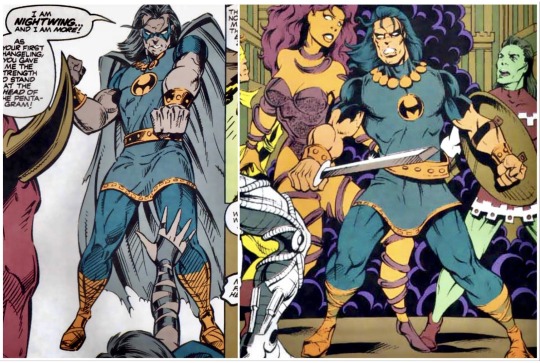
Elseworld Nightwing in New Teen Titans Annual # 10. Written by Marv Wolfman and Louise Simonson, art Scott Lee, Martin Griffiths, Kevin Conrad and Dan Davis. (1994)

Rebirth suit with glider wings. Nightwing vol 4 # 6. Written by Steve Orlando and Tim Seleey, art Roge Antonio. (2016)
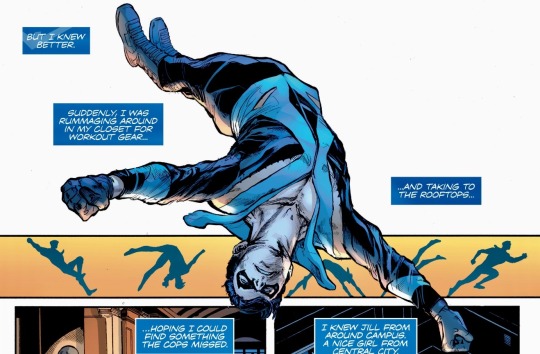
Nightwing vol 4 # 39. Writer Sam Humphries, art Jamal Campbell, Phil Jimenez, Matt Santorelli. In a flashback, the first version of the “discowing” suit is made of Dick’s old workout gear. (2018)

Which artist doesn't love to be able to make new suits for their heroes...? At different times in future-timelines of Future State, Dick was shown wearing several different models.
Future State: Nightwing # 1. Writer Andrew Constant, art Nicola Scott. (2021)
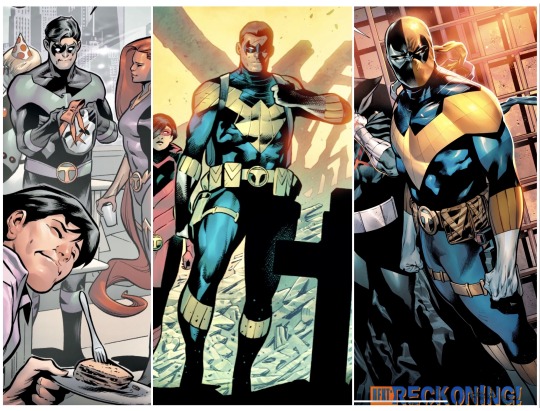
The Future State: Teen Titans story takes place a few years after Nightwing, but there's also a flashback with Dick in a suit that looks a lot like his current, but with a T on the belt. Future State: Teen Titans # 1. Writer Tim Sheridan, art Rafa Sandoval and Jordi Tarragona. (2021)

Teen Titans Academy # 1. A prequel title for the Future Staten Teen Titans that, honestly, I don’t expect will ever come to pass because I don’t believe a comic book company will or can tie their main comic book line to a future set in stone...
But anyway, it’s pretty much the current (2021) suit and the same as seen in the Furure State flashbacks. The old Titans have a T on their ordinary suits. Writer Tim Sheridan, art Rafa Sandoval. (2021)
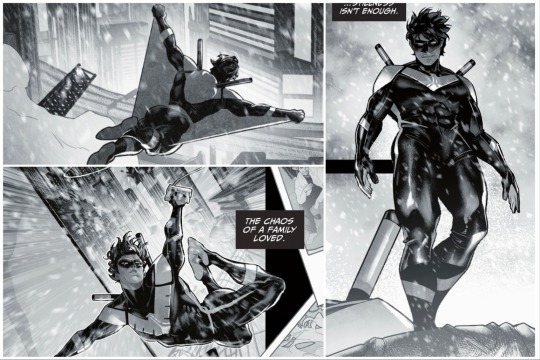
The Man who Flies. in Batman Black & White (2021) # 5. Story and art Jamal Campell. A version of the Rebirth suit with glider wings – and it's probably those wings which gives the suit stripes on the side of his torso in a lighter colour.

Titans United # 1 (2021), a comic tied to the tv- show Titans.
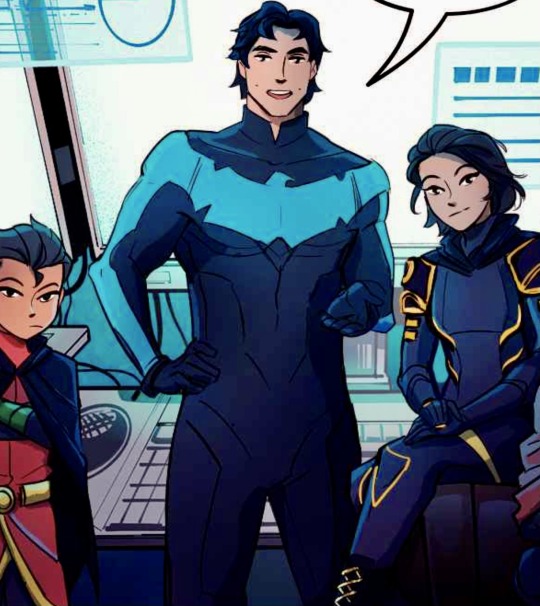
Nightwing in the Fanon-friendly Webtoon Batman: Wayne Family Adventures (2021). Episode # 7. Writing CRC Payne, inks Starbite, flats & rendering C M Cameron.

Young Justice: Phantoms, season 4 (2021).
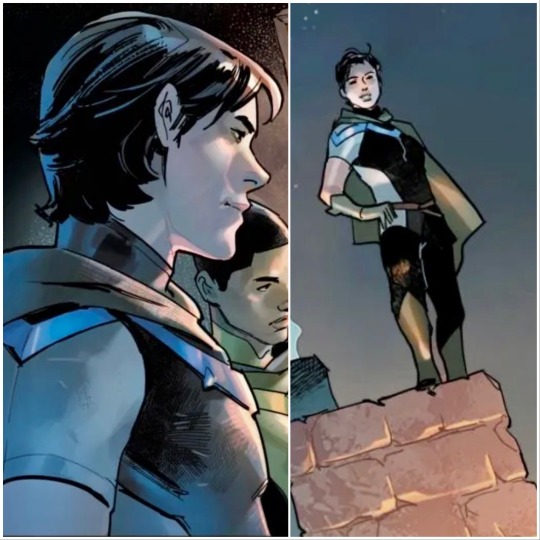
In the Fantasy AU comic Dark Knights of Steel (2021). # 1, writer Tom Taylor, art Yasmine Putri.

Nightwing in the 2021 animated Injustice movie, where he of course dies and becomes the new Deadman.

Nightwing dress uniform in Teen Titans Academy # 9 (2021).
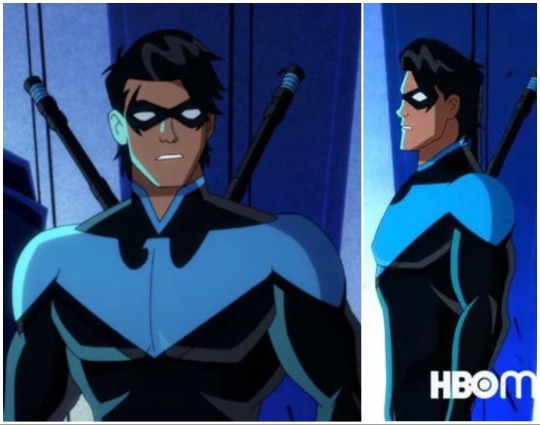
Nightwing in the third season of the animated Harley Quinn on HBO Max, with Harvey Guillen as voice actor. (2022)
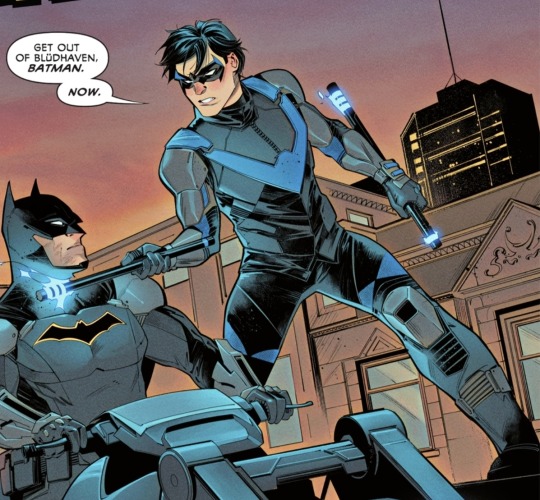
Batman: Gotham Knights – Gilded city # 2 (2022), a tie-in prequel comic to the game Gotham Knights.


A number of costume options for Nightwing in the Gotham Knights game (2022).

Matching biker jacket in Nightwing vol 4 # 93 (2022).

Another version with glider wings in Nightwing vol 4 # 94 (2022).

Nightwing vol 4 # 104. (Dick gets a temporary new suit when he is tempted by a bad guy with the powers of Superman.)


In Batman Superman: World’s Finest # 21 (2023), main universe Batman and Superman visits Earth-22, known from Kingdom Come where Dick was called Red Robin. Here, he is called Nightwing and the artist Dan Mora wrote on X/former Twitter that this takes place before Dick became Red Robin. So there appears a retcon of Dick’s history on Earth-22 has taken place.

(At least, it would make his daughter’s codename Nightstar more logical, if her parents were Starfire and Nightwing rather than Robin/Red Robin. And in the comic The Kingdom: Nightstar from 1999, a younger Dick is seen with a Nightwing-like suit.)
Se also Dick Grayson’s Nightwing suits, Part one:
https://northoftheroad.tumblr.com/post/618292087194025984/dick-graysons-nightwing-suits
161 notes
·
View notes
Photo
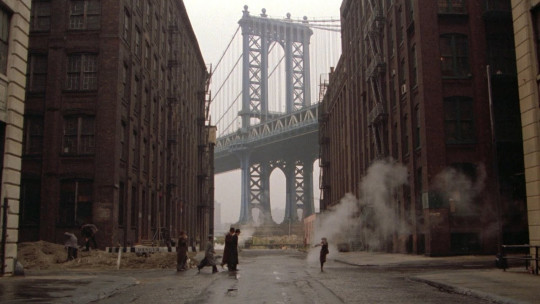
Once Upon a Time in America (1984)
Italian director Sergio Leone made a name for himself worldwide with the Dollars trilogy of Westerns starring Clint Eastwood as the Man with No Name. These movies, along with Once Upon a Time in the West (1968), had more stylized violence than the typical Hollywood Western, and audiences flocked to see what some waved off as pulp novelties. During this period, an idea had been reverberating in Leone’s mind; no longer could he ignore his imagination’s wills. Leone’s success led him to spend ten years working on this passion project, even declining an offer to direct The Godfather (1972). Based on The Hoods by Harry Grey, Once Upon a Time in America is a gangster epic filled with betrayal, crime, graphic violence, and regret. The film alternates between three time periods: the late 1910s/early ‘20s, the final three years of Prohibition from 1930-1933, and 1968. It is Leone’s most ambitious project after a thirteen-year absence from filmmaking, and his last.
In New York City’s Lower East Side, we follow a handful of young Jewish boys who engage in petty thievery, grow to complete contracts for organized crime, and later make their fortunes bootlegging during Prohibition. The film centers on David “Noodles” Aaronson (Robert De Niro as adult Noodles; Scott Tiler as a child). He is first seen in a Chinese opium den in 1933 after seeing three of his friends’ corpses – burnt beyond recognition – whisked away from a crime scene. A non-diegetic telephone rings during this wordless montage – a blaring, ceaseless ringing serving as an aural pang of guilt. That guilt will be gradually explained as the film progresses. Soon after this opium-induced retreat, Noodles will depart New York City for Buffalo. He will return decades later, his hair and soul fading, after receiving a suspicious invitation. Once Upon a Time in America’s first half concentrates on Noodles’ childhood, alternating with scenes from his 1968 return. The film’s second half intercuts between Prohibition and 1968.
Noodles’ boyhood friends are the protagonist’s de facto family. They include Patrick “Patsy” Goldberg (James Hayden as adult Patsy; Brian Bloom as a child), Philip “Cockeye” Stein (William Forsythe as an adult Cockeye; Adrian Curran as a child), Dominic (Noah Moazezi), and Maximillian “Max” Bercovicz (an excellent and up-and-coming James Woods as adult Max; Rusty Jacobs as a child). Fat Moe (Larry Rapp as an adult Moe; Mike Monetti as a child) is not part of the gang, but is nevertheless a friend who knows their secrets. The film also features Noodles’ young love interest, Deborah (Elizabeth McGovern as adult Deborah; a debuting Jennifer Connelly as a child) and friend/underage prostitute Peggy (Amy Ryder as adult Peggy; Julie Cohen as a child). Also appearing in the film are Joe Pesci (whose unclear role in the film is heavily downplayed in the European cut), Burt Young, Tuesday Weld, Treat Williams, and Danny Aiello. Louise Fletcher's cameo appears only in the most recent restoration.
Before continuing with this review, I want to note that there are multiple versions of Once Upon a Time in America available to viewers. Leone’s film debuted at the 1984 Cannes Film Festival with a runtime of 229 minutes (the “European cut”). For the American general release one week later, the film’s distributor (the Ladd Company, via Warner Bros.) cut the film to 139 minutes without Leone’s permission or input. The American theatrical cut – which was released on VHS in the 1980s and ‘90s and sometimes appears on television – rearranges scenes to play in a strictly chronological structure and removes essential plot details, essentially butchering Leone’s directorial intent. A 2014 Blu-ray release of Once Upon a Time in America includes additional footage bringing the runtime to 250 minutes, but the additional footage – due to the degradation of the original negative – appears worse for wear. This review is based on the European cut, which is the recommended print for all those seeing this film for the first time.
With a screenplay by Leone, Leonardo Benvenuti, Piero De Bernardi, Enrico Medioli, Franco Arcalli, and Franco Ferrini, Once Upon a Time in America is told through the lens of an unreliable narrator in Noodles. How one views the film changes radically depending on which period should be considered the “present”. If the viewer interprets Once Upon a Time in America as using the 1968 scenes as its anchor, the film is an old man’s reverie – where a lifetime of guilt is revisited and ghosts are confronted. In this interpretation, are Noodles’ memories of his childhood and young adulthood sanitized to spare him further pain? How does he square with all the pain he has been responsible for? Or perhaps one might view Once Upon a Time in America using 1933, as Noodles retreats to the opium den, as the anchor. Here, the 1968 scenes become an opium dream or a nightmare, a painful future that may have been. If indeed this is an opium-induced dream (which would make the 1968 scenes nothing but a hallucination), does that make the childhood scenes even less genuine than in the former interpretation? That Leone and his writers never force the viewer down either avenue speaks to its thoughtful screenplay.
No matter how one reads this film, it requires complete attention. Characters age over fifty years, friendships are formed and destroyed, and innocence is forever lost. Whether it is viewed as an old man occupied by his violent past or a young gangster attempting to smoke away his pain, Once Upon a Time is awash in regret. As much as viewers might sympathize with Noodles, Leone’s film portrays Noodles’ violence as the result of terrible choices influenced by his friends. Granted, there is one occasion where he kills in self-defense. But even that killing is laced with rage and revenge. Faced with the choice between his friends and the money involved with their operations and being with Deborah, Noodles will attempt to have both. Deborah’s disapproval of the gang’s behavior – her opposition becomes more tacit as she ages – assures that Noodles retain some semblance of a conscience as Max’s arrogance permeates through all their friends. Neither fully committing to the appeals from Deborah or his friends, Noodles will lose both.
In the film, smoke or steam is usually present just before or during moments tinged of bittersweet memory. Whether emanating as puffs from an opium pipe, the steam billowing from New York City’s manholes on a frigid day, or discharges from a passenger train, it is a demarcation of an event that will irrevocably affect Noodles’ life. Potentially, due to the film’s openness to interpretation, smoke or steam may also herald moments where Noodles’ memories are most suspect – through conscious reframing of his story or opium-influenced phantasms. Either way, certain narrative threads are left incomplete, raising questions over whether those dangling characters and subplots were Leone’s original intention. Perhaps Leone here is acknowledging the voids in human memory – people and things half-forgotten. Unlike its genre counterparts, Once Upon a Time in America leaves little space for comic relief. Any levity in the film is snuffed out almost immediately due to monstrous lust, performative masculinity, or Noodles’ weariness. The elderly Noodles is stone-faced, wrapped into a world frozen in time the moment he boarded that train to Buffalo. His pain is omnipresent in Once Upon a Time in America. Even in the earliest scenes of his childhood, the years of rumination can be felt in the film’s deliberate pace. Robert De Niro and Scott Tiler, respectively, embody the older Noodles’ sorrow and the younger Noodles’ conflicted feelings.
Like American Western films, the gangster genre is rife with mythologizing and, at times, a glorification of their protagonists’ violent lives. Where Westerns over the last half-century have deconstructed their role in the American mythos, the gangster film – probably because gangster films were never as ubiquitous as Westerns at their respective pinnacles of popularity – has not done so nearly as much introspection. Before Martin Scorsese’s Goodfellas (1990) and especially The Irishman (2019), Once Upon a Time in America stood mostly alone among gangster films as a rueful examination of its protagonist’s violent lifestyle. The film consistently undermines its characters’ celebrations and successes with the consequences of their prior actions. Those consequences weigh on Noodles still.
But Leone is not entirely successful in this regard. Once Upon a Time in America has two overlong rape scenes – both of which turned my stomach the longer they went on – following a fruitful robbery (this one follows an unsettling submissive fantasy by its victim) and a glamorous date, respectively. The two rapes are committed by Noodles; both scenes serve to highlight his descent into depravity rather than express a minimal concern for the victim. Once Upon a Time in America, already uninterested in developing its female characters beyond sex objects, frames Noodles as a husk of a man because of the murders and robberies he has committed, not his treatment of women. Just because the film has adopted Noodles’ viewpoint – in his childhood and young adulthood, he cannot differentiate between objectification and love – does not mean Leone and his screenwriters can wave away his misogyny as secondary to his violent tendencies. His misogyny and criminality are distinguishable, but both were learned from the same people and environment. This dynamic persists even from the first moment that Jennifer Connelly appears as the young Deborah. There, Deborah sexually teases the young Noodles in a way that neither reflects her personality as a child or as an adult. Is that the result of the opium clouding Noodles’ memory or is it Noodles’ obsession with Deborah?
Once Upon a Time in America is beautifully shot by Tonino Delli Colli (1966’s The Good, the Bad and the Ugly, 1997’s Life Is Beautiful) and edited by Nino Baragli (The Good, the Bad and the Ugly, Once Upon a Time in the West). Like a photograph that has faded somewhat but still captures the likeness and character of its subjects, the brown environments and warmly-lit interiors capture the spirit of these neighborhoods of New York City’s Lowest East Side. Life is hardscrabble here, with those born into the prevalent poverty rarely escaping from it. Their Jewishness, verbally and visually, is strangely downplayed by Leone. The film’s long takes – several last over thirty seconds – without any cuts from Baragli allow the viewer to reflect on its changing characters, internalizing the film’s scope and depth of Noodles’ introspection. For the 1968 scenes, the browns are mostly replaced by overcast grays in exterior and interiors. The colors, no longer as warm or as diverse, help the film navigate its temporal and tonal transitions.
youtube
Ennio Morricone’s powerful score does even more to strengthen the film’s emotional power. The recently-passed composer, best known for his work on Leone’s Dollars trilogy, was a classically-raised/taught, jazz-loving experimenter whose sound could be bold and brash. Upending expectations for what the Western could sound like with anachronistic electronic elements and guitar, Morricone suspends any anachronisms for his Once Upon a Time in America score. The viewer will hear an odd pan flute (not Morricone’s decision) and diegetic/non-diegetic jazz music, but the defining aspect of the score is its romantic minimalism. One does not associate minimalism with grand emotions, but the score’s romantic minimalism – encapsulated by “Deborah’s Theme” – does not preclude the pathos it evokes. The rests in the lushly-orchestrated “Deborah’s Theme” (according to Morricone himself, despite the cue’s name, it can also be interpreted as the film’s main theme) reflect Noodles’ silent longing and remorse. Even at mezzo piano with no dialogue or sound effects present, Morricone’s cues pierce the soul. As longtime collaborators, Leone respected Morricone’s talents, allowing his friend and colleague’s music to be the star for long stretches. Leone allows Morricone to envelop the viewer in its textural splendor. The orchestral renditions of “Amapola” and The Beatles’ “Yesterday” are effective in placement and arrangement. Whether it is his theme for childhood and poverty, for the film at large, or for Deborah, Morricone’s score to Once Upon a Time in America is an essential part of his film scoring career – a career that spans so many titles, that most of it has not been heard outside of his native Italy.
Before and when making this film, Leone intended to direct two films running around 180 minutes each. Convinced by his producers to whittle Once Upon a Time in America to the 269-minute version that should be sought for a first viewing, Leone was horrified to hear that the Ladd Company – frightened by the runtime and (justifiably) the rape scenes – decided to eviscerate his film. When word eventually (and inevitably) reached Leone’s North American fans that they would not be receiving a version of Once Upon a Time in America that respected Leone’s authorial voice, the film bombed at the box office and was savaged by most anyone who saw it. To some critics including the Chicago Tribune’s Gene Siskel, Once Upon a Time in America’s American theatrical version was the worst film of 1984; in an about face for those same critics, the European cut was the best film of 1984. Eighteen minutes of footage for Once Upon a Time in America have still not seen the light of day due to continuing legal entanglements surrounding them. Leone’s ardent admirers remain hopeful for their eventual inclusion on a future print.
As he challenged the tropes of American Westerns, so too did Leone subvert what might be expected from a gangster film. Or, perhaps with a cynical grin, Leone is challenging the essence and veracity of cinematic narrative. Once Upon a Time in America is an underappreciated, imperfect movie whose reputation continues to grow the further removed it is from its botched release. America’s traditions of tall tales and melting pot storytelling make villains and bystanders of the unsavory characters contained within. Haunted by a past that cannot be changed, Noodles attempts to reclaim his life’s story from those who have written it. As the viewer, we project our anxieties and insecurities onto images spliced to make narrative sense. Authorship disputes and the struggle between legend and fact permeate cinema. Seldom do they converge as movingly as they do here.
My rating: 9.5/10
^ Based on my personal imdb rating. Half-points are always rounded down. My interpretation of that ratings system can be found in the “Ratings system” page on my blog (as of July 1, 2020, tumblr is not permitting certain posts with links to appear on tag pages, so I cannot provide the URL).
For more of my reviews tagged “My Movie Odyssey”, check out the tag of the same name on my blog.
#Once Upon a Time in America#Sergio Leone#Robert De Niro#James Woods#Elizabeth McGovern#Joe Pesci#Burt Young#Tuesday Weld#Danny Aiello#James Hayden#William Forsythe#Larry Rapp#Ennio Morricone#Tonino Delli Colli#Nino Baragli#TCM#My Movie Odyssey
10 notes
·
View notes
Text
DC Fandome: Complete DC TV Panel Schedule
https://ift.tt/eA8V8J
We’re very excited for next Saturday’s DC Fandome. Honestly, the DC Entertainment-run virtual event looks way more impressive that Comic Con at Home, boasting 24 hours of content for fans of the page and screen stories of DC Comics to nerd out over. DC just released the complete schedule for the event and, while there’s plenty of big screen stuff to look out for, from Wonder Woman 1984 to The Batman, there’s also some pretty exciting TV content on the docket. Here’s the complete DC TV schedule, with times (in ET) and panel descriptions.
DC Superhero Girls Season 2 Sneak Peek – 1 pm
A long-awaited character will be making their debut in season two of DC Super Hero Girls. Do you know who it is? You will soon!
The Flash – 1 pm
Executive producer Eric Wallace joins cast members Grant Gustin, Candice Patton, Danielle Panabaker, Carlos Valdes, Danielle Nicolet, Kayla Compton and Brandon McKnight to discuss all things Flash with Entertainment Weekly’s Chancellor Agard. Team Flash will break down both parts of season six and look ahead at what is to come with an exclusive trailer for season seven. Fans will also get a look at the exclusive black-and-white noir episode “Kiss Kiss Breach Breach,” available on the Season 6 Blu-ray and DVD.
Teen Titans Go! – 1 pm
Don’t miss a special cast table read of some of your favorite moments from the series with executive producer Peter Michail and voice cast members Tara Strong, Khary Payton, Greg Cipes and Scott Menville.
Black Lightning – 1:45 pm
Join Black Lightning stars Cress Williams, China Anne McClain, Nafessa Williams, Christine Adams, Marvin “Krondon” Jones III, Jordan Calloway and James Remar with actor/filmmaker Robert Townsend moderating as they pay homage to the ’90s.
Truth, Justice, and the DC Comics Way – 1:45 pm
Who would have thought the “injustices of the world” first read in comic books and then acted out in some of today’s most popular DC Super Hero films and television series would intersect with today’s real-life civil, social and political unrest? Series stars David Harewood and Nicole Maines (Supergirl), Marvin “Krondon” Jones III (Black Lightning), Anna Diop (Titans) and executive producer/showrunner Eric Wallace (The Flash) discuss how the genesis of comic books has always been rooted in the search of truth and justice: it’s the DC Comics way!
Multiverse 101 – 2:15 pm
Get schooled in this engaging refresher course on the creation of the Multiverse with DC Chief Creative Officer/Publisher Jim Lee, Warner Bros. Pictures President of DC-Based Film Production Walter Hamada, and Berlanti Productions founder/DCTV mega-producer Greg Berlanti.
Pennyworth – 2:30 pm
Join series stars Jack Bannon, Ben Aldridge, Paloma Faith, Emma Paetz, and executive producers Bruno Heller and Danny Cannon as they talk about this unique origin story of the famed butler behind Batman, Alfred Pennyworth. Join in for a fond look back at the show’s exciting first season and the inspiration behind its stunning and edgy 1960s London setting, plus a few unexpected secrets about the new season ahead!
DC’s Legends of Tomorrow – 3 pm
Join the cast and producers of DC’s Legends of Tomorrow for a Q&A and, of course, lots of laughs! Be sure to tune in to get the inside scoop on favorite moments from past seasons and what they have in store for season six. Series stars Caity Lotz, Nick Zano, Matt Ryan, Tala Ashe, Jes Macallan, Olivia Swann, Amy Louise Pemberton and Shayan Sobhian join executive producers Phil Klemmer, Keto Shimizu and Grainne Godfree for a panel moderated by Entertainment Weekly’s Chancellor Agard.
BAWSE Females of Color Within the DC Universe – 3:45 pm
What’s a BAWSE? Find out here as some of the hottest actresses across DC television and film sit down with celebrity DJ D-Nice and Grammy-winning singer/actress Estelle to discuss how they use their confidence and vulnerability to navigate their careers in Hollywood. Panelists include Meagan Good (SHAZAM!), Javicia Leslie (Batwoman), Candice Patton (The Flash), Tala Ashe (DC’s Legends of Tomorrow), Nafessa Williams and Chantal Thuy (Black Lightning), and Anna Diop and Damaris Lewis (Titans).
Doom Patrol – 4:15 pm
Join the “world’s strangest heroes” — the Doom Patrol — for a deep-dive discussion into the beloved and bizarre series. Panel will feature executive producers Jeremy Carver and Chris Dingess, co-executive producer Tamara Becher-Wilkinson, and series stars Matt Bomer, Diane Guerrero, April Bowlby, Joivan Wade, Timothy Dalton, Karen Obilom, Abigail Shapiro, Riley Shanahan and Matthew Zuk.
Superman & Lois – 5:35 pm
Join DC Chief Creative Officer/Publisher Jim Lee in a conversation with executive producer/showrunner Todd Helbing and series stars Tyler Hoechlin and Elizabeth Tulloch as they discuss the history of Superman from the comics to the screen, what fans can expect from the upcoming series, and the significance of the characters in the world of today.
Lucifer – 8 pm
Lucifer is back from Hell, and the series is bringing a never-before-seen blooper reel from season four along with an exclusive clip of “Another One Bites the Dust” from the upcoming musical episode. Director Sherwin Shilati and Lucifer executive producers/showrunners Joe Henderson and Ildy Modrovich discuss what it took to put together such a massive musical episode — and how they have been able to keep it under wraps for so long.
Titans – 8:30 pm
Join executive producer Greg Walker and series stars Brenton Thwaites, Anna Diop, Teagan Croft, Ryan Potter, Conor Leslie, Curran Walters, Joshua Orpin, Damaris Lewis, with Alan Ritchson and Minka Kelly for a preview of the new season as well as a discussion on the “Top Titans Moments” of the first two seasons.
Young Justice – 9 pm
Join executive producers Greg Weisman and Brandon Vietti plus voice cast members Jason Spisak, Khary Payton, Stephanie Lemelin, Nolan North, Denise Boutte, Danica McKellar and Crispin Freeman for a special audio play performance of a brand-new Young Justice episode. After the table read, stick around for a Q&A session previewing the new season.
DC’s Stargirl – 9:45 pm
DC’s Stargirl creator/executive producer Geoff Johns joins cast members Brec Bassinger, Amy Smart, Yvette Monreal, Anjelika Washington and Cameron Gellman for a panel full of fun and inside scoop. Join the new Justice Society of America as they dive into that epic showdown and learn a little more about each other through some special lenses.
Batwoman – 10:30 pm
Join executive producers Caroline Dries and Sarah Schechter plus cast members Rachel Skarsten, Meagan Tandy, Camrus Johnson and Nicole Kang for the exclusive first discussion with the highly anticipated new Batwoman Javicia Leslie as she prepares to step into the iconic role. The cast will break down season one and give a sneak peek at season two, featuring new arrival Ryan Wilder, aka Batwoman.
The post DC Fandome: Complete DC TV Panel Schedule appeared first on Den of Geek.
from Den of Geek https://ift.tt/2E4cCUF
2 notes
·
View notes
Text
off the rack #1208
Monday, April 16, 2018
Today is going to be challenging here in Ottawa. Freezing rain overnight has left thick ice on everything. It's going to take a lot of muscle and time to scrape off any cars parked outside overnight. Penny has been going at hers for half and hour and she still hasn't left for work. I would normally go out and help her but I caught a bad cold and I feel like poop. I probably got the bug on the flight home from Cuba last Tuesday. My immune system let me down this trip.
Our week at the Brisas Guardalavaca resort in Cuba was near perfect. Beautiful sun every day. I took one of the resort bikes out for a ride on one of the only cloudy mornings, got rained on a little but made it back to the resort unscathed. I donned mask, snorkel and fins every afternoon but one to swim out to look for tropical fish on what remained of the reefs after last year's hurricanes. I'm happy to be home but I wish winter would finally leave the area. Just going to stay in today and try to get better.
Domino #1 - Gail Simone (writer) David Baldeon (art) Jesus Aburtov (colours) VC's Clayton Cowles (letters). Killer Instinct part 1. It's my lucky day. The merc with the facial tattoo is back on the racks and she's being take care of by a writer and artist team that I like a lot. This story starts off with Neena Thurman's birthday but may end in her death day. If I didn't like this whole issue and the many guest stars so much, that last page guarantees that I will be reading the next issue.
Immortal Men #1 - Jim Lee, Ryan Benjamin & James Tynion IV (storytellers) Jim Lee & Ryan Benjamin (pencils) Scott Williams & Richard Friend (inks) Jeremiah Skipper & Alex Sinclair (colours) Carlos M. Mangual (letters). The End of Forever part 1. I used to get excited when I saw Jim Lee's name attached to a new project because his art was so fantastic. At least to me it was. His X-Men and Batman stuff made me go "wow". Now I look at his art and feel meh about it. This latest New Age of Heroes book introduces a team of immortals that are brand new to me. None of them made a positive impression. I didn't finish reading the Dark Nights Metal stories and this team ties in to that series so that's probably why I couldn't get into this debut. These Immortal Men will be short-lived.
Xerxes #1 - Frank Miller (story & art) Alex Sinclair (colours). I really liked 300 when it hit the racks 20 years ago. This new 5-issue mini promises to be just as good. This time the Greeks and the Persians go at each others' throats in 490 BC. I have an interest in ancient history so I'm going to follow this story to see what happens.
Exiles #1 - Saladin Ahmed (writer) Javier Rodriguez (pencils & colours page 4) Javier Rodriguez (pencils) Jordie Bellaire (colours) VC's Joe Caramagna (letters). Here we go again with Blink leading a team of heroes to save the multiverse. This first issue introduces two team members and the big bad guy that they'll be facing. I liked this debut. It reminded me of the Unstoppable Wasp book with young Nadia. I really enjoyed Javier's art in Spider-Woman so I'm giving this new book a chance.
Batman #44 - Tom King (writer) Mikel Janin & Joelle Jones (art) June Chung & Jordie Bellaire (colours) Clayton Cowles (letters). I loved the silent scenes where Selina picks out her wedding dress. Those pages are interspersed with flashbacks showing different times in Batman and Catwoman's tumultuous relationship. The lead up to the wedding has been amazing. I'm starting to get a bad feeling about the blessed event however. The "'til death do us part" part may be a nasty surprise that the creative team are going to spring on us. I really hope not.
Oblivion Song #2 - Robert Kirkman (writer) Lorenzo De Felici (art) Annalisa Leoni (colours) Russ Wooton (letters). Still liking this adventures in monster land series.
Runaways #8 - Rainbow Rowell (writer) Kris Anka (art) Triona Tree Farrell (colours) VC's Joe Caramagna (letters). Julie Power/Lightspeed is all grown up. I remember reading Louise Simonson and June Brigman's book when it first hit the racks in 1984 and loving the Power Pack kids. I never would have thought that Julie would mature into the woman she is now and would be dating Karolina. Julie's visit to her girlfriend's is interrupted by a surprise villain who wants Victor's head. I was surprised because I thought he was a good guy now.
Superman #44 - Patrick Gleason & Peter J. Tomasi (writers) Doug Mahnke (pencils) Jaime Mendoza & Doug Mahnke (inks) Wil Quintana (colours) Rob Leigh (letters). Bizarroverse part 3. Thank Darkseid this story is over. This climax had more Bizarro characters so the confusion I felt while reading this issue was increased exponentially. Even the sound effects were Bizarro. I hope we get back to normal next issue.
American Gods: My Ainsel #2 - Neil Gaiman (writer) P. Craig Russell (script & layouts) Scott Hampton (art) Rick Parker (letters). Find out why this arc is called My Ainsel.
Spider-Man #239 - Brian Michael Bendis (writer) Oscar Bazaldua (art) Brian Reber (colours) VC's Cory Petit (letters). The Sinister Six deliver their stolen S.H.I.E.L.D. helicarrier to the buyer. A special guest star team helps Miles to stop the handover. Somebody is going to die I bet.
Detective Comics #978 - James Tynion IV (writer) Javier Fernandez (art) John Kalisz (colours) Sal Cipriano (letters). The villain tips his hand this issue. I just noticed that all the ad pages were in the back of this book so that reading the story was a lot smoother. I wish every comic book was printed that way.
Avengers #687 - Mark Waid, Al Ewing & Jim Zub (writers) Paco Medina (pencils) Juan Vlasco (inks) Jesus Aburtov & Frederico Blee (colours) VC's Cory Petit (letters). No Surrender part 13. The Avengers find out what they're involved in as Voyager confesses to her duplicitousness just in time for the bad guy to ratchet up his threat to destroy the planet. The scene between Jarvis and Bruce Banner bodes well for the return of the Hulk.
Avengers #688 - Mark Waid, Al Ewing & Jim Zub (writers) Kim Jacinto & Stefano Caselli (art) David Curiel (colours) VC's Cory Petit (letters). No Surrender part 14. The Avengers need every hero they can assemble to defeat the Challenger after he crowns himself the Grandmaster Prime. It's going to take a lot of sacrifice to save the doomed planet. Who will not survive is the question.
Old Man Hawkeye #3 - Ethan Sacks (writer) Marco Checchetto (art) Andres Mossa (colours) VC's Joe Caramagna (letters). Clint is hunting Thunderbolts and Bullseye is hunting Clint. We all know that Clint doesn't die in this story because he still has to go on a road trip with Old Man Logan. I'm curious to see how he survives Bullseye.
New Mutants #2 - Matthew Rosenberg (writer) Adam Gorham (art) Michael Garland (colours) VC's Clayton Cowles (letters). The team gets sent to the Arctic to deal with a giant problem. Meanwhile a new New Mutant makes a surprise appearance on the last page. Maybe Doug Ramsey will show up too.
Amazing Spider-Man #798 - Dan Slott (writer) Stuart Immonen (pencils) Wade von Grawbadger (inks) Marte Gracia (colours) VC's Joe Caramagna (letters). Go Down Swinging part 2. I love the design of the new Red Goblin. The sacrifice that Peter has to make to keep himself and everyone he loves safe is huge. Now we'll see if he can come up with a way to beat the Red Goblin without his web shooters.
Marvel 2 in One #5 - Chip Zdarsky (writer) Valerio Schiti (art) Frank Martin (colours) VC's Joe Caramagna (letters). Ben and Johnny find themselves in a universe where GalacDoom has eaten everything except Earth. Now he's going to eat it too. Then what? There's nothing left to eat. Not very bright, GalacDoom. Seeing the Silver Surfer and Emma Frost doing the Smallville thing was cool though.
All-New Wolverine #33 - Tom Taylor (writer) Ramon Rosanas (art) Nolan Woodard (colours) VC's Cory Petit (letters). Old Woman Laura part 1. We jump into the future where Laura is queen of Madripoor after the good guys win Doom World War. Wait until you see who the POTUS is. Laura has only months to live due to a genetic glitch and one of the items on her bucket list is to kill Victor Von Doom. Someone shows up in the last panel and April 25, when the next issue hits the racks, can't come soon enough for me.
Astonishing X-Men #10 - Charles Soule (writer) Aco (pencils) David Lorenzo (inks) Rachelle Rosenberg (colours) VC's Clayton Cowles (letters). A Man Called X part 4. As much as I liked Aco's art in the Nick Fury mini, I didn't think it suited that spy versus spy story. It's perfect for this reality warping story though. The team tries to save the villagers of Fetters Hill in the Scottish Highlands from the villain Proteus before he can spread his madness even further. I'm interested to see how they do that.
X-Men Red #3 - Tom Taylor (writer) Mahmud Asrar (art) Ive Svorcina (colours) VC's Cory Petit (letters). The Hate Machine part 3. I don't remember much about the villain Cassandra Nova but it's clear she's one very nasty person in the first three pages. I'm not usually a fan of super hero teams but Tom Taylor writes the All-New Wolverine and Gabby and Laura are on this team so this book stays on my "must read" list.
Star Wars: Darth Vader #14 - Charles Soule (writer) Giuseppe Camuncoli (pencils) Daniele Orlandini (inks) David Curiel (colours) VC's Joe Caramagna (letters). Burning Seas part 3. Vader is sent to the oceanic planet of Mon Cala to hunt down some surviving Jedi that slipped through the Empire's clutches when Order 66 was executed. The defiant Mon Calamari are thwarting his efforts. Mmm…calamari is yummy.
Captain America #700 - Mark Waid (writer) Chris Samnee (art) Matthew Wilson (colours) VC's Joe Caramagna (letters). So disappointed that a time paradox was used to beat the bad guy. All that matters to Cap fans is that Steve is back in the "present" and the series continues.
1 note
·
View note
Text
I Eat Cannibals (1980) Ted Nicolaou’s forgotten action comedy. This was to be the “the most ferocious story of revenge ever filmed.”

Leatherbabies (1984) Story unknown at this time.

Alter Ego (1985) Directed by Peter Manoogian (Arena), another early Paul De Meo and Danny Bilson effort that was to star Jeffrey Byron (of Empire’s The Dungeonmaster) as a sci-fi hero pitched halfway between Mandroid and Jack Deth. The film never got beyond initial planning due to lack of interest from international buyers. Brian Yuzna (Re-Animator) and Rob Goethals (Swamp Thing) were also attached as producer & writer at a stage prior to Bilson/De Meo coming on board.
Crimelord (1985) Some kind of crime/cop movie .
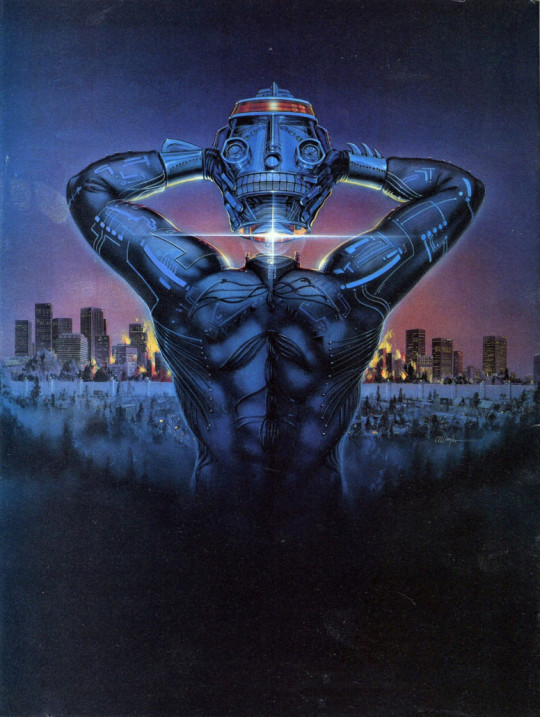
Decapitron (1986) Interchangeable technology is a popular theme at Empire. One of the more ambitious films is Decapitron, currently subtitled “The Devastation Creation” and also written by Paul De Meo and Danny Bilson. The Decapitron is a robot with five different heads: a surveillance head, which is an extremely sophisticated information gathering and observation device, an omnitech head, which is an all-purpose utility-super analyzer unit useful for biochemical breakdowns, medical diagnosis and crime detection; a humanoid head, which can simulate the appearance of any human male in his mid-thirties; a war head with advanced firepower, and finally, a doomsday head, the ultimate weapon of last resort.
The film was to be directed by Peter Manoogian, however, following the collapse of Empire Studios in 1989, and no doubt fueled by the cool reception given to Empire’s other ‘big’ picture Robot Jox, the script was finally shelved. Bilson & De Meo then went on to write the screenplay for the Disney’s The Rocketeer in 1991. The character of Decapitron was, however, to re-appear in micro-form as one of the puppets in Jeff Burr’s entry in the Full Moon killer toy franchise Puppet Master 4 and Puppet Master 5.
Paul De Meo acknowledges that “Decapitron” is an outgrowth of Eliminators, which was an intriguing idea. Charles Band wanted to go further with it. While the Mandroid is half man, half machine, the Decapitron is all robot. Unlike the Terminator, he’s the good guy. He has a kid sidekick, and they go into a city which has its own rules there’s been a plague in the city and it is under quarantine. The inhabitants are survivors of a biological disaster.”
Bilson and De Meo believe that a good sense of humor delicately applied can compensate for a less than generous budget. Trancers derives humor from its bizarre situation and future slang. In Eliminators, the Mandroid keeps commenting on how unbelievable and comic-book-like the whole thing is, putting the audience on his side. De Meo is aware that the proper tone for a picture is important. He and Bilson like to add humor but they are making action pictures, not comedies. Also, I may be wrong, but I remember hearing this film would’ve been Charles Band’s most expensive picture ever.
This slideshow requires JavaScript.
Why then are you spending $10 million on Decapitron? Charles Band: If one or two pictures out of 25 cost that much and all the rest average $2-3 million, we’re still pretty true to our formula. There are pictures that will cost more only because of what it’ll take to make them. It’s not because we’re putting in a $4 million star or spending a million dollars on a director. Decapitron has huge amounts of special effects, pyrotechnics, pieces of city blocks getting blown up it’s just an expensive movie to make. Sometimes a project comes along that we’re so excited about that we want to do it justice. Many pictures we make are designed to be made on a budget, but we don’t want to short- change the story or the movie itself. You can make, in theory, a brilliant horror film if your location is a house. You don’t need $20 million and a lot of special effects. On From Beyond, for example, we have not only John Buechler, who is our close effects associate involved, but we have three other FX teams, too. There’s a huge amount of special effects half the budget of this expensive picture Is going to effects. But again, if your picture takes place In a house in this case, a very large house it’s limited in many potential costs. But If your picture takes place in the future on some planet, in Los Angeles on city streets, with many effects, it costs money. In the case of Decapitron and one other picture that we’ll be announcing soon, the budgets are up there. But everything else is averaged out at about $3 million.
“I did read the DECAPITRON script. It was pretty good though there was a fundamental flaw in the premise. The central character was supposed to carry 5 or 6 replacement heads capable of different functions. Since, in reality, the heads would be masks worn by an actor, they would have to be larger than normal. The script described him carrying them in something the size of a briefcase when it would really have to be the size of a footlocker. Imagine a character dodging bullets and running through action scenes lugging something that big!” – Kenneth J. Hall (film-maker)


Barbarian Women (1986) Another sword and sorcery film, probably set in the future or another dimension.

Bloodless (1986) Jungle/Ancient horror maybe. Slasher or vampire. Anyone got anything?
Journeys Through The Darkzone (1986) Written by Danny Bilson and Paul De Meo (Eliminators), I got nothing much on this. The title was used later as a tagline for Trancers 4.


Show No Mercy (1986) Would be action flick directed by Peter Manoogian.
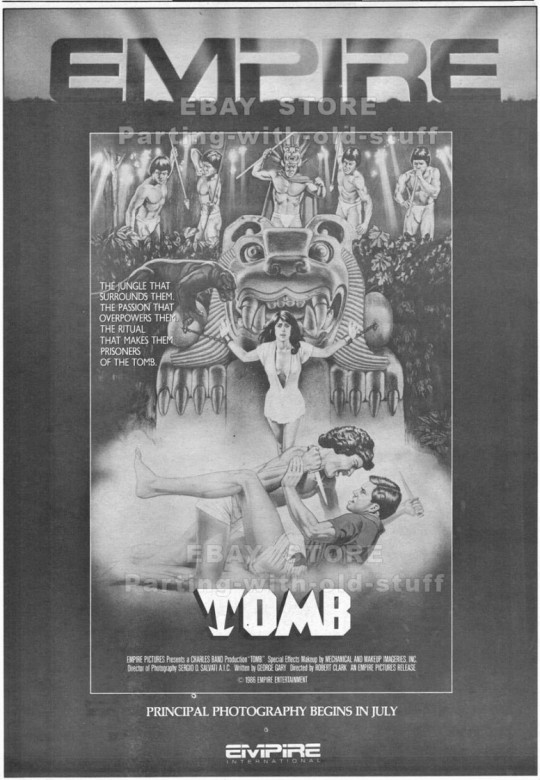
Tomb (1986) Unmade jungle thriller.
Murdercycle (1986) Originally titled BATTLE BIKES, info is unknown on this version, but fans would later see this art and title recycled for a future Full Moon release about soldiers fighting a robotic alien.
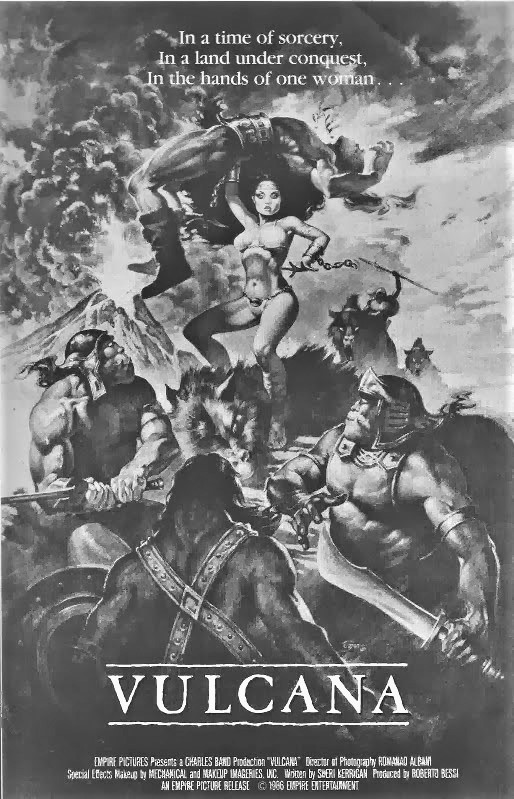
Vulcana (1986) Action/fantasy about a warrior woman.
Charles Band & Jack Kirby Unfilmed Projects
This slideshow requires JavaScript.
Mindmaster (1986) involves a scientist who is caught in an accident which leaves him debilitated, and must use a thought-controlled robot he invented to stop a crazed fellow scientist.

Doctor Mortalis (1986) is an all-powerful wizard, the leader of a secret sect of sorcerers known as The Dark Order. His faithful sidekick, “Egghead,” is a witty half-human, half computer genius who possesses fantastic special powers.
Legion of Doom This was going to be Charles Band’s superhero team movie. He once stated that films like Mandroid and Invisible: The Chronicles of Benjamin Knight were efforts to slowly build characters for a team movie. So it’s entirely possible Dark Angel and Doctor Mordrid could have been on the team as well in this movie.
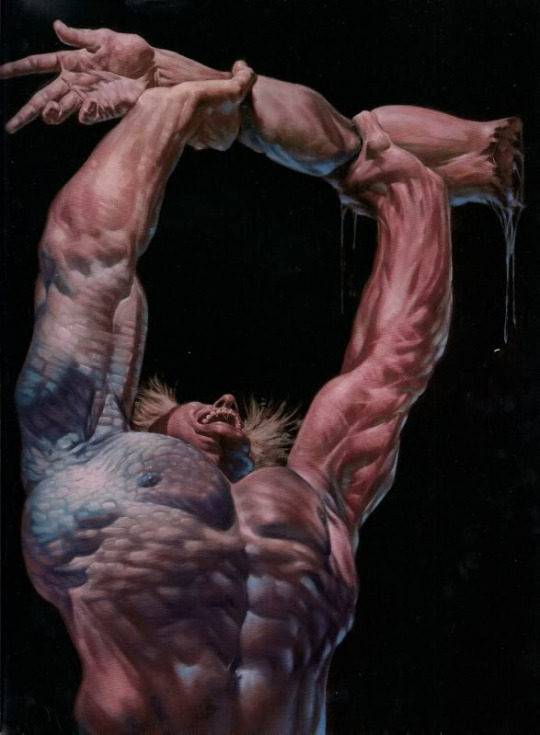
Berserker (1986) Unfilmed A big fan of RE-ANIMATOR, Arnold Schwarzenegger and Stuart Gordon and Dennis Paoli wrote BERSERKER, about a bodybuilder who abuses steroids and becomes a mutant.

Bloody Bess (1987) Unfilmed Stuart Gordon planned this adventure movie around the time he was making From Beyond, and also first attempting to raise a decent budget for his pet project The Shadow Over Innsmouth. It was to star Jeffrey Combs, and Barbara Crampton as a female pirate, out to drink rum, steal gold, and generally show the boys a thing or two about buckling swashes. Rumour has it ex-Empire director Renny Harlin (Prison, Die Hard 2) must have liked the idea, since he lifted it for his 1995 box-office bomb Cutthroat Island, which I have never bothered to watch.

Pand Evil (1987) To be produced and directed by Gorman Bechard (Psychos In Love, Cemetery High).

Fiends (1987) Info not known at this time.
PULSEPOUNDERS (1988) Incomplete An unfinished Empire Pictures film directed by Charles Band, and starring Tim Thomerson, Helen Hunt, Jeffrey Combs, Barbra Crampton, and Richard Moll.
Here’s what I’ve heard Charles Band had to say about PulsePounders: “PULSEPOUNDERS is completely shot, it just needs post-production,” says Band. “I still hope to get it out of the mess it’s tangled up in and release it. David Gale is terrific in it, and with him gone now, it’s all the more reason to get it out where people can see him one last time.”

Now here’s what Jeffrey Combs had to say: “Pulsepounders is a real curiosity,” Combs says. “It’s a movie – or a segment of a trilogy – that i did back in the 1980’s while over in Italy. As far as I knew, that movie never got finished. Empire Pictures, Charlie Band’s company at that time, tanked. So that film was in pieces and incomplete, and so far as I’d heard just lost in the wars. Now it’s showing up on the internet as something that’s coming out. I did my segment soon after Re-Animator with Barbara Crampton, the late David Gale and David Warner. Other than the dailies I saw at the time, I never heard or saw anything about it again until information about it suddenly turned up on the internet. So who knws about that. Maybe the next time I talk to Charlie Band, I’ll ask him about it.”

“I was in a segment called ‘The Evil Clergyman‘, based on a Lovecraft story, Combs continues. “They did a short Trancers / Jack Deth story “Trancers: City of Lost Angels” which Helen Hunt was in. And they did one more with Richard Moll, based on another Empire Pictures movie [Dungeonmaster] that had been successful. So it would have been three little odd and hastily connected pieces. They’d all been shot, but they were never able to finish them up.
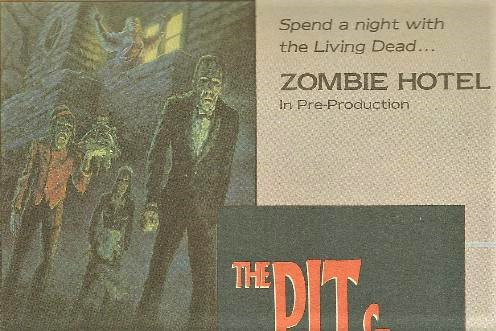
Zombie Hotel (1989) “Spend a night with the Living Dead.” Subspecies director Ted Nicolaou was set to direct.
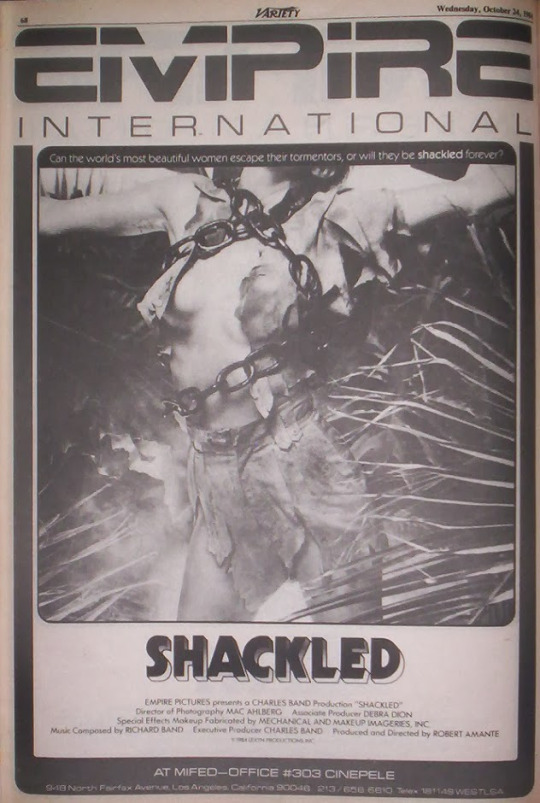
Apparatus (1989) A Futuristic thriller that was to have been directed by Larry Cohen (It’s Alive) that apparently concerned “Big Brother'” types controlling the masses through apparatus attached to their bodies. Abandoned also when Empire Pictures folded.

Hotel Dick (1989) Another Empire comedy to be produced by Frank Yablans (Buy & Cell, The Caller).
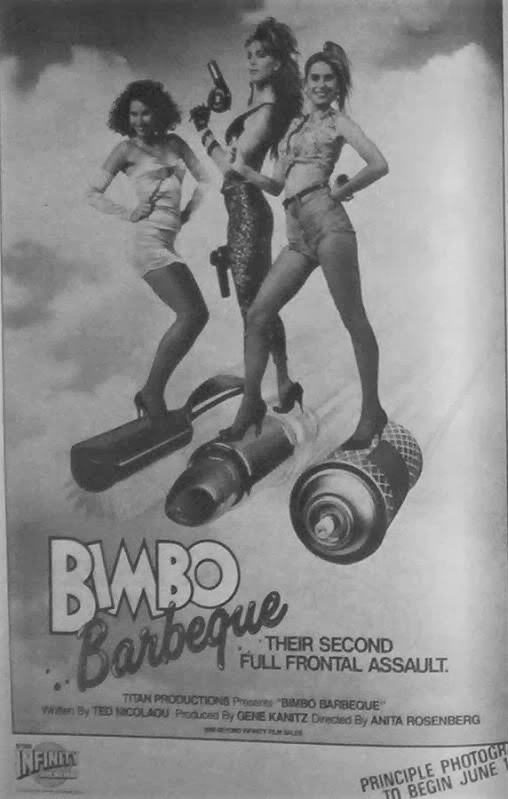
Bimbo Barbeque (1989) A planned sequel to Assault of the Killer Bimbos, a girls on the run sex comedy that inspired THELMA & LOUISE. It’s mentioned in ASSAULT’s end credits.
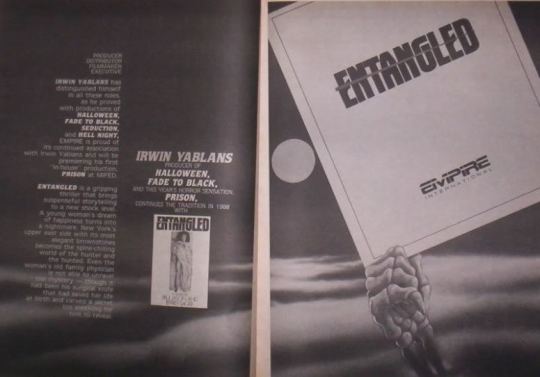
Entangled (1989) Would’ve been produced by Irwin Yablans (Halloween).
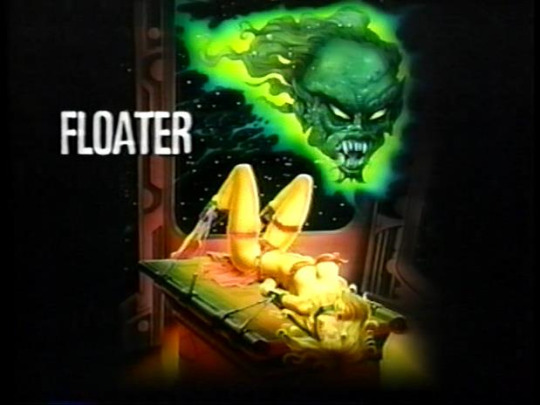
Floater (1989) Tobe Hooper (Texas Chainsaw Massacre 1 & 2) signed on to make a $6 million supernatural thriller, one of Band’s occasional attempts at ‘top-drawer’ quality product. Again, the project was abandoned when Empire ceased. Tobe went on to direct Spontaneous Combustion instead.
Subterraneans (1989) Heard this was to be the first of a trilogy about a culture of small evolved apes that live in the NYC Subway Tunnels.
Empire Films Never Made Undated

Arsenal A no doubt action adventure.
This slideshow requires JavaScript.
Cassex Virtual reality sex comedy.

The Colony Apparently about yuppie witches.

Dolls 2 Director of the original Stuart Gordon was, at one point, very interested in directing a sequel. The initial storyline would have followed surviving characters Judy and Ralph back to Boston in which Ralph would have indeed married Judy’s mother and they would all become a family. Until, one day Judy would receive a box sent from England which would contain the toy makers, Gabriel and Hilary, as dolls. Gabriel was played by Guy Rolfe (Andre Toulon in Puppet Master 3, 4, 5, 7) by the way. It’s unknown to me why it was never made.

InHuman Info unknown at this time.
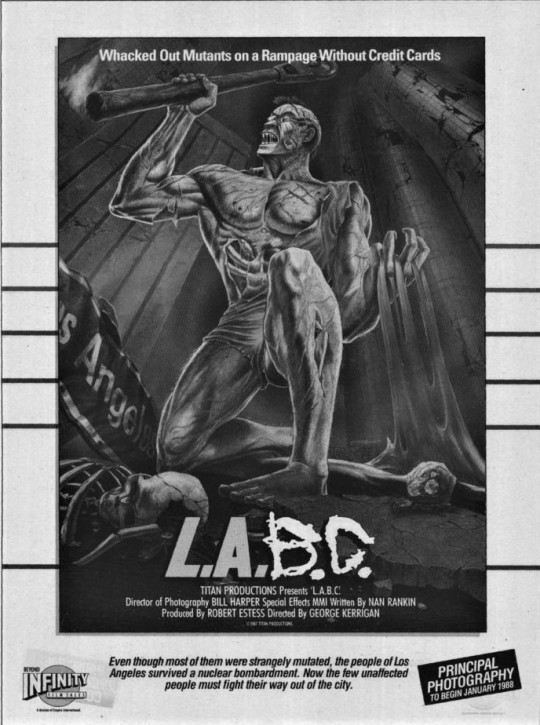
L.A.B.C. Anyone got anything? I suspect this to be a post-apocalyptic film, which were big in the 1980’s.
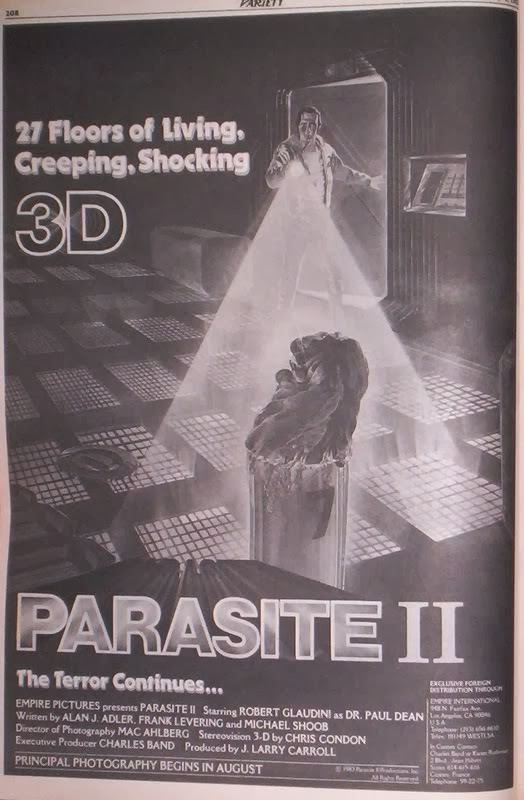
Parasite II Following the Charles Band/Demi Moore original, the sequel never hit the script stage after Embassy Pictures fell apart. According to the poster below, actor Robert Glaudini was expected to return.
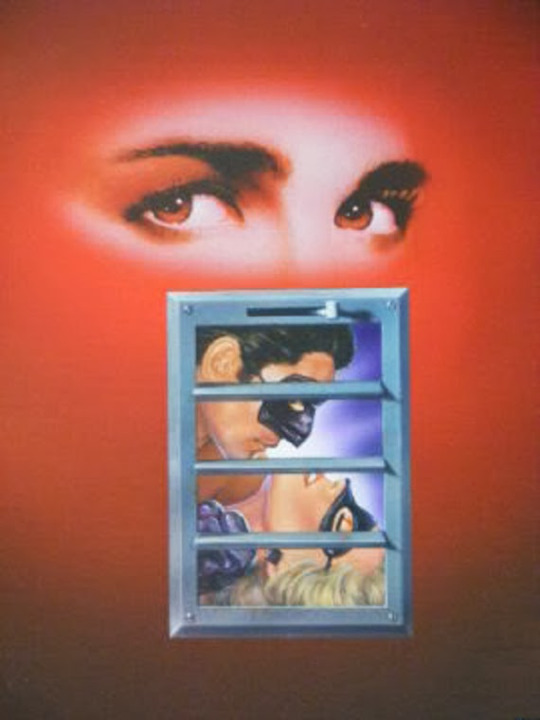
Shadows and Whispers Unknown about this possibly erotic thriller, to be directed by David Schmoeller (Crawlspace).
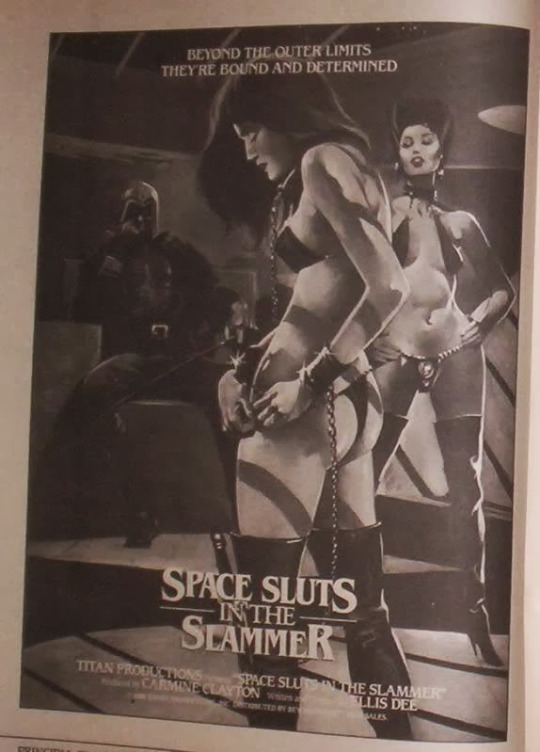
Space Sluts in the Slammer Possibly part of Charlie’s uncredited erotic Sci-Fi adventures like Slave Girls from Beyond Infinity.
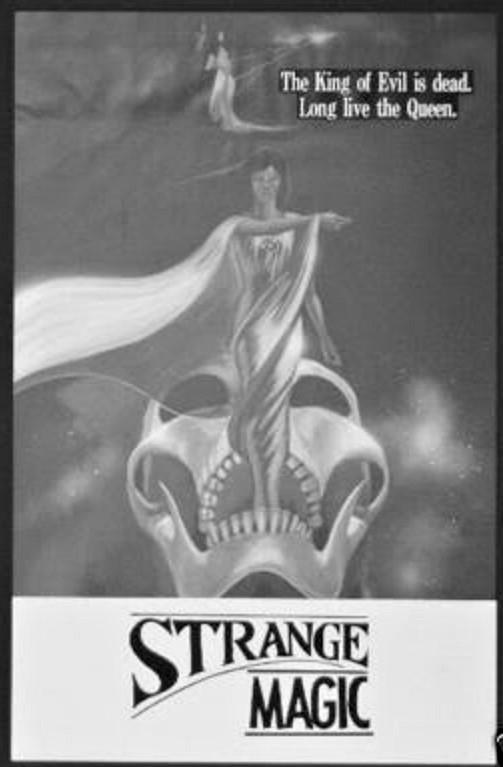
Strange Magic I got nothing other than this poster. “The King of Evil is dead. Long live the Queen.”
-tomboftheunproducedhorrormovie
The History of Empire Films Part Seven – Films Never Made (1980-1989) I Eat Cannibals (1980) Ted Nicolaou's forgotten action comedy. This was to be the "the most ferocious story of revenge ever filmed."
0 notes
Text
Flashback Friday: Power Pack
Flashback Friday: Power Pack

Every Friday we use the powers of Marvel Unlimited to look back at the very first appearance of a major character, place or object that made waves this week. Comics might not just be for kids anymore, but it’s important to have some that they can read. That was part of the mission statement when Louise Simonson and June Brigman launched POWER PACK in 1984. With POWER PACK #63 hitting stores…
View On WordPress
0 notes
Text
Nice Low Price Chinese Line Milling photos
Posted from 5 axis machining China blog
Nice Low Price Chinese Line Milling photos
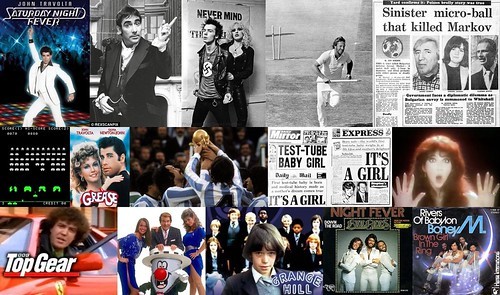
Check out these low price chinese line milling images:
That Was the Year That Was – 1978

Image by brizzle born and bred 1978 Following on from the oil crisis Japanese car Imports account for half the US import market. The first first ever Cellular Mobile Phone History of Mobile Phones is introduced in Illinois and Space Invaders appears in arcades Launching a Craze for Computer Video Games.
Sweden is the first country in the world to recognize the effect of aerosol sprays on the Ozone Layer and bans the sale. The Serial killer David Berkowitz, "Son of Sam," is convicted of murder after terrorizing New York for 12 months. 1978 is also a great year for movies with Grease summer opening on June 16th, Saturday Night Fever and Close Encounters of the Third Kind all showing in Movie Theatres around the world.
‘Britain was the Sick Man of Europe’. The unions and inflation were out of control. Our inefficient nationalised industries were an expensive disaster. The Labour governments of 1974-79 were complete flops.
The winter of discontent began in private industry before spreading to the public sector. The strikes seriously disrupted everyday life, causing problems including food shortages and widespread and frequent power cuts.
Prices
Average house price: £13,820
Milk (1 pint): 11p
Bread (800g loaf): 28p
Cigarettes (20): 58p
1978 – the year of over abundance of polyester flares and bouffant hair, Grease and Superman at the cinema and the invention of the Sony Walkman. Worldwide unemployment rises after several decades of near full employment.
The US Dollar plunges to record low against many European currencies. The US stops production of the Neutron Bomb. India faces it’s longest and worst monsoon season in modern times leaving two million homeless. Due to poor Cold War Relations United States bans sale of latest computer technology to Soviet Union.
The first online forum goes online forum – the CBBS – goes online in Chicago. One user at a time can post a message.
Argentina captain Daniel Passarella raises the World Cup Trophy as he is carried shoulder high by fans after Argentina had beaten Holland 3-1 in the 1978 World Cup Final. The Vatican has three popes: Pope Paul VI dies at age of 80, Pope John Paul I becomes Pope from August 26th and dies just 33 days later on September 28. Cardinal Karol Wojtyla then became Pope John Paul I shortly after.
Sweden became the first nation to ban aerosol sprays that are thought to damage earth’s protective ozone layer. Sony built its first prototype Walkman. Grease became the biggest grossing film and ‘You’re the One that I Want’ was number one for nine weeks. The Garfield cartoon strip was published for the first time.
In a year with more than its share of notable deaths there was also one very notable birth. A little before midnight on 25 July, Louise Brown, the world’s first IVF baby, was born.
The 5lb 12oz (2.61 kg) girl ushered in a fertility revolution that continues to this day.
The former Italian prime minister Aldo Moro was kidnapped and murdered by the Red Brigades; Pope John Paul, head of the Roman Catholic church for just over a month died, and Carl Bridgewater, a 13-year-old paper boy, was shot dead after disturbing a burglary in Staffordshire.
Georgi Markov, a Bulgarian dissident, was murdered in London with an umbrella that carried a poison pellet. In Jones town, Guyana, 918 people died in a mass suicide.
The musical world said goodbye to Keith Moon, Jacques Brel, and – most notoriously of all – Nancy Spungen, who was stabbed to death in the Chelsea hotel in New York by Sid Vicious of the Sex Pistols.
The Bee Gees continued to dominate the charts thanks to their soundtrack to the previous year’s Saturday Night Fever, although Boney M (Rivers of Babylon), Paul McCartney (Mull of Kintyre), and Kate Bush (Wuthering Heights) also found chart success. The Sex Pistols played their last gig together and Rod Stewart asked: Do Ya Think I’m Sexy?
Audiences headed to the cinema to watch Danny Zuko pursue Sandy Olsson in Grease, a goofy reporter from the planet Krypton pursue Lois Lane in Superman, and Turkish justice pursue an American drug smuggler in Midnight Express.
Those huddled around smaller screens saw Roman Polanksi flee to the UK and then France to escape the pursuit of US justice after admitting unlawful sexual intercourse with a 13-year-old girl. They also witnessed the TV debuts of, among other shows, Grange Hill and Dallas.
Ipswich Town beat Arsenal 1-0 to win the FA Cup.
Democratic government returned officially to Spain after a referendum approved a new constitution and the Nobel prize for literature was won by the Polish-born American writer Isaac Bashevis Singer.
Keith Moon of the Who Dies
On Sept. 7, 1978, the world lost one of its most unique children when Keith Moon left us, far too soon. Much more than simply ‘the drummer for the Who,’ Moon defiined the term “one of a kind” not only in his ability and style behind the drum kit, but in his utter irreverence and over the top way of life.
Moon was born on August 23, 1946. By the time he was in his teens, was already turning heads as a drummer. His joining the Who was nothing short of perfect. He added a much needed component to their equation, acting as the comic foil to the often very serious Pete Townshend. Moon’s drumming style seemed to border on pure chaos, but in reality he was always firmly in control behind the wheel.
And what a ride! Unlike the subtle, yet effective, approach of contemporaries like Charlie Watts or the rock solid Ringo Starr, Moon took an entirely different sensibility to the drum kit, inspiring countless future musicians along the way. Add in bassist extraordinaire John Entwistle, and the Who had themselves a rhythm section with the range of an orchestra.
Moon’s short, sweet life came to and end after a night of partying — and to be fair, a lifetime of testing his own limits. Ironically, his death was caused from an overdose of pills that were intended to combat his ongoing alcoholism. The medication was primarily a sedative, only a handful of which would have caused death. Police reports indicate that he took nearly a third of his 100 pill prescription. “It was a silly mistake,” said Pete Townshend in the 2007 documentary ‘Amazing Journey.’ “He just always took pills in handfuls, it was just a habit that he had.” Heminevrin, the prescribed drug in question, disabled his esophagus, which prevented him from vomiting, thus suffocating him. While Moon was no stranger to chemical intake, he never hit on hard drugs, prefering alcohol and pills to be his demon.
“He was never going to grow old gracefully,” said manager Bill Curbishley, “I don’t think he was destined to make old bones. I suppose he was designed in such a way to be remembered as he was.” Sadly, the band had just begun a new chapter in their career with the release of the ‘Who Are You’ album just weeks prior to Moon’s death. At the time, fans cryptically noted that on the cover, Moon is sitting on a chair that has the words ‘Not To Be Taken Away’ stenciled on it. A madman behind, and away from the drum kit, he didn’t earn the nickname ‘Moon The Loon’ for nothing. The tales of his crazed behavior is the stuff of legend, but 32 is far too young for him to have checked out.
Botham sets all-rounder record
Ian Botham’s test cricketing career was sprinkled with many records, some of which still stand: he five times bagged five wickets in an innings and scored a century in the same match (the next best is twice); he was the first test player ever to score a century and take 10 wickets in a match; and he is still the leading English test wicket taker, his total of 383 likely to have been far higher had his speed not been hampered in the latter part of his career with a back injury that eventually forced his retirement.
Ian Botham came to the game as a life force, his verve in stark contrast to many of those who batted with him – Boycott , Tavaré and Brearley for example. Having burst on the test scene aged 21, taking a more than creditable 5 – 74, and scoring 25 in his one knock, he was soon a fixture in the side.
In his second international season Botham showed himself as a true all rounder, in the Trent Bridge Test against Pakistan setting a record still not bettered in world cricket : he scored a dashing 108 (though it should be remembered that while immensely powerful Botham was also a very ‘correct’ batsman), and then devastated the visiting side with swing bowling that most found totally unplayable, taking 8 – 34.
Mike Brearley, his captain, called him a colossus; Wasim Bari the opposition captain described him as a magnificent cricketer, and so he certainly was.
Cambridge Sink In Boat Race
It began in 1829 (when on June 10 the Oxford boat won), and became an annual thing in 1856. Since then the varsity boat race has been part of our sporting calendar, though given (as has frequently been pointed out) the same two teams always get to the final, and that results that go against form are infrequent, it rarely offers fingernail biting tension.
But on six occasions in its history the boat race has managed to spring the surprise of a sinking, the first time in 1859, and the most recent in 1984. In 1912 both boats sank, forcing a re-rowing on the following Monday. For some reason the sinking that most stays in the memory was that in 1978. Choppy waters from a more than brisk sou’wester made life difficult for both crews. Past Chiswick Steps Oxford had a lead, but at about a boat length it was nowhere near as much as experts had expected, giving the Cambridge crew hope of a comeback over the last stages. But it was not to be.
Through Barnes Bridge and to observers the end for the Cambridge boat was all but inevitable. Their stroke realised first, or at least allowed himself to believe what he was seeing. He waved his arms above his head to signal the bitter end. For some reason while Oxford had sensibly fitted splash-boards to their boat, Cambridge had gambled that they could do without them.
They were wrong. Water from the rough surface of the Thames splashed over their boat and filled it.
TV crews had a field day. For the first time since 1951 we were being treated to the sight not just of muscular and brilliant young men – Hugh Laurie one of them in 1980 for example, and the ill-fated mountaineer Sandy Irvine in 1922 and 1923 – in a test of character, endurance and skill, but of those same chaps ignominiously sinking. Let’s face it, this was at least half the result most of us wanted.
Was it unsporting of Oxford to refuse a re-match? Not really, they were leading even with the extra weight of the splash-boards. And the Thames that March weekend was a pretty blustery spot. There were no drownings by the way.
First Episode of Grange Hill
In 1975 Phil Redmond failed to persuade ITV that his idea had legs; but the BBC was less short-sighted, and in early 1978 the first episode of a commissioned nine was broadcast. In the end the series ran for 30 years.
Kids’ TV at this time was rather cosy – nothing wrong with Blue Peter of course, but variety is the spice etc. Grange Hill was something that senior school pupils could identify with far better than variations on The Famous Five.
The programme eased its way in at first, but eventually storylines included rape, bullying including some of a very heavy face-slashing sort, and famously heroin addiction. The tough stuff was often balanced by comedic elements, though not always perhaps intentional – Rowland – that provided real dramatic contrast.
The show was a proving ground for acting and production talent over the years, with Todd Carty and Susan Tully both graduating to Eastenders and beyond; Anthony Minghella working as a script editor on it early in his career; even TV presenter and DJ Reggie Yates acting in it. Most significantly it launched the career of Redmond, who later developed Brookside and Hollyoaks, and helped rescue Emmerdale from oblivion with a controversial storyline, a technique not unknown in Grange Hill.
First Test Tube Baby Born
IVF – in vitro fertilisation – is now regarded as almost commonplace, though with many ethical issues still hotly debated. But when Louise Joy Brown was born, a healthy baby weighing 5lb 12oz, it was world news. She was the first so-called ‘test tube baby’.
Patrick Steptoe, a consultant gynaecologist, and Robert Edwards, a research physiologist, had been developing their techniques in the field of in vitro (in glass) fertilisation since the mid-1960s. They had found a successful way of fertilising eggs outside the womb, but once the egg had been returned to the mother the pregnancy would last a matter of weeks at best.
The medical team in this specific case decided to return the egg to the mother’s womb much earlier than previously, after two and a half days rather than twice that time, as they had done previously.
Lesley Brown, the 29-year-old mother-to-be, had been unable to conceive because her fallopian tubes were blocked. She and husband John, 10 years her senior, had agreed to the experimental procedure, desperate to have a child. The egg successfully embedded on Lesley’s uterus wall, as many had in other women undergoing the procedure before. But this time the egg stayed in place, grew, and the pregnancy continued with little or no concern until nine days before the expected due date, when Lesley Brown developed high blood pressure and it was decided to deliver the baby by caesarean section.
So at 11.47pm on July 15 1978 Louise Joy Brown came into the world, a gift for headline writers at the time, and a greater gift for her parents, who later had a second child, Natalie, by the same method.
Hitch Hikers Guide First Broadcast
In a 1970s radio comedy world of gentle topical sketch shows and long established panel games The Hitch Hiker’s Guide to the Galaxy by Douglas Adams was finally something new: different, witty and very quirky indeed. This was perhaps surprising as like so many of those employed by the BBC then and now main actors Simon Jones (Arthur); Geoffrey McGivern (Ford), and Mark Wing-Davy (Zaphod); producers Simon Brett and Geoffrey Perkins; and of course writer Adams all had the seemingly obligatory Oxbridge background. This dominance was leavened in Hitch Hiker’s Guide by the calm suavity of the great Peter Jones as The Book and RSC actor Stephen Moore as Marvin the Paranoid Android.
The creators fought the BBC to allow their series to be different: dubbing it drama to get permission to record in stereo; and lobbying to avoid the usual BBC radio comedy studio audience requirement. The first episode was broadcast on March 8 1978, less than a week after the production was finally completed.
The logical lunacy of the plot was compellingly unreal; and some of the lines like “Time is an illusion; lunchtime doubly so,” (as in the olden days pubs used to close after lunch) became instant classics. Word of mouth quickly saw to it that the programme gained a big following, and eventually cult status.
Murder of Carl Bridgewater
It was a case that shocked the nation. On September 19 1978 13-year-old Carl Bridgewater was nearing the end of his afternoon paper round when he delivered a newspaper at Yew Tree Farm near Stourbridge in Staffordshire. As the occupants were disabled he, as previously, opened the back door to drop the paper on the kitchen table. On this occasion the elderly couple who lived in the farmhouse were absent. It appears he disturbed a burglary. Dragged to the sitting room he was murdered, shot in the head at point-blank range.
The cold-blooded nature of the execution-style killing horrified all who heard about it. The police were under great public and political pressure to find the killer or killers. But that pressure led to wrongdoing by at least one police officer involved in the investigation, and a gross miscarriage of justice.
Following another similar burglary in the area Staffordshire Police rounded up four men, and after lengthy and allegedly violent interrogation one of them, petty crook Patrick Molloy, having been shown a confession by another of the gang, confessed himself, though he retracted his confession as soon as he was given access to a solicitor; nevertheless it was central to the conviction of Molloy and his three associates.
Scientific investigation of that first confession years later showed conclusively it had been fabricated, something one officer involved in the interrogations, the late DC John Perkins, was found in his subsequent career to have done on at least three other occasions. After various failed appeals, the surviving three members of the so-called Bridgewater Four were released in February 1997 pending a further appeal, their convictions quashed in July of that year.
Who really killed Carl Bridgewater is not yet known. Incredibly and tragically fingerprint evidence pointing to the presence of someone other than the Bridgewater Four at the crime scene – prints found on Carl’s bike which was hidden out of sight at the farm – was ignored at the time.
Naomi James Globe Circling First
The 1970s was a decade when women in Britain not only secured greater rights, but also demonstrated by example the idiocy of sex discrimination. Most notably of course Margaret Thatcher became Prime Minister in 1979 ; but the year before Naomi James set a sporting record that made it harder for chauvinists to play the weaker sex card.
James, New Zealander by birth but a resident of Devon when she set her record, was in her mid-twenties when she learned to sail, but before she was 30 she had become the first woman to circumnavigate the globe solo (discounting the effort of a Pole who used the Panama Canal and sailed to and from the Canaries contrary to the accepted rules for the feat). She used a yacht borrowed from Chay Blyth , originally The Spirit of Cutty Sark but because of the sponsorship and support she received from The Daily Express renamed Express Crusader.
When she reached Dartmouth harbour just after 9am on June 8 1978 Mrs James – soon made Dame Naomi for her achievement – shaved two days off the record set by Sir Francis Chichester. Following the so-called clipper route she had been at sea for 272 days; had capsized; rounded Cape Horn; and lost her kitten overboard.
As a footnote, the techniques and technology of sailing changed rapidly over the next three decades: on February 7 2005 Ellen Macarthur took the record after a voyage of 71.5 days.
Sid Vicious Arrested for Murder
Sid Vicious epitomised the extreme wing of punk music. The Sex Pistols bass player who couldn’t play bass but became famous anyway for his antagonistic attitude; his self-harm; his nihilism; and most destructively of all his drug addiction.
By the autumn of 1978 Vicious had left the Sex Pistols . He and his girlfriend of well over a year Nancy Spungen, who some say introduced him to heroin, were living in New York, staying at the bohemian Chelsea Hotel. On the morning of October 12 1978 Vicious found his girlfriend in the bathroom; she had one stab wound to her abdomen, and had bled to death. Both had taken heroin the previous night; the knife that killed her was one bought by Sid.
The police who came to the hotel arrested the punk rock star. At various points he supposedly admitted knifing Nancy, but not having intended to kill her; and that somewhat improbably she had fallen on the blade. Others have put forward theories that a drug dealer delivering supplies had tried to rob the couple with Vicious out cold, and been disturbed by Nancy; or that another addict killed her.
In February 1979 Vicious died of a heroin overdose while on bail awaiting trial for the murder.
Accident, suicide, or even according to some murder, as his mother allegedly later confessed to the deliberate administration of the fatal dose? As with the murder of Nancy Spungen, his death remains a mystery, a sordid yet still tragic mystery. Nancy was 20 when she died; Vicious 21.
The Umbrella Murder
Georgi Markov was a man with many achievements to his name: he had been a successful novelist and short-story writer in his homeland of Bulgaria; after his defection in the 1970s several of his plays were staged in Britain; and he became a broadcaster with the BBC and Radio Free Europe among others. But it is for his mysterious death that he is best remembered.
On September 7 1978 Markov was waiting at a bus stop near Waterloo Bridge, en route to his job at the BBC, when he felt something sting his right thigh. Behind him a man was picking up an umbrella, apologising to Markov who thought little of the incident. The stranger hurried across the road to a taxi which whisked him away.
Later in the day Markov told a colleague or colleagues at the BBC what had happened. The pain in his leg had not gone away, and that evening a fever gripped him to such an extent that he was immediately hospitalised. Four days later he died.
An autopsy revealed a tiny – 1.5mm diameter – platinum and iridium sphere in his leg. The hollow object pierced by two holes had contained ricin, a poison with no known antidote. The ricin was kept in place by a coating over the holes, that coating designed to melt at body temperature. Markov had been assassinated, and in a very sophisticated manner.
It was probably no coincidence that September 7, the day of the attack on the writer, was the birthday of Bulgarian leader Todor Zhivkov. Markov in his broadcasts had attacked Zhivkov’s nepotistic activities and inauguration of a system of privileges for his cronies and supporters, the living example of Orwell’s Animal Farm phrase ‘All animals are equal, but some animals are more equal than others.’ Tyrants and dictators are not good with criticism.
The crime now referred to as ‘the umbrella murder’ had not been solved at the time of writing, or at least nobody had been brought to justice for it: The Times among others has identified a claimed perpetrator. It is not even clear that an umbrella gun was used – in a subsequent attack on another defector in Paris no umbrella was carried by the putative assassin.
But until the full facts are known, Georgi Markov’s death will always be associated in the public consciousness with a deadly umbrella.
1978 The Yorkshire Ripper Murders
31 January – 18-year-old prostitute Helen Rytka is murdered in Huddersfield; she is believed to be the eighth victim of the Yorkshire Ripper.
It didn’t take a police dog very long to locate Helen Rytka’s body after Rita finally confessed to working as a prostitute and relayed the events of the night to the police. Ten minutes after the search of the timber yard in Great Northern Street began at 3:00 pm on Friday, February 3rd, her body had been located in a narrow space behind a pile of timber and a disused garage. She had been covered with a sheet of asbestos. Her clothes had been scattered over a wide area, one of her shoes was found twenty yards away. Her bra and black polo-neck jumper had been pushed up above her breasts, but other than her socks, all other clothing had been removed. There were three stab wounds to the chest, including indications of multiple stabs through the same wounds, and scratch marks on her chest.
26 March – The body of 21-year-old prostitute and mother-of-two Yvonne Pearson, who was last seen alive on 21 January, is found in Leeds. The Yorkshire Ripper is believed to have been responsible.
The police were left with several puzzles. To begin with, they found it inconceivable that her body would not have been discovered earlier by someone with her arm sticking out so obviously, unless it had been moved by a dog. As well a copy of the Daily Mirror, dated February 21st, exactly one month after the murder, was found under one of her arms, looking, apparently, deliberately placed. Peter Sutcliffe would later deny that he had returned to the body, continuing the mystery.
The second, and more important puzzle, was whether or not it was a Yorkshire Ripper killing. There were the massive head wounds, but Professor David Gee’s examination led him to believe they had been caused by a boulder, and not a hammer. There weren’t any stab wounds, but her clothing had been arranged in typical Ripper fashion, her bra and sweater above the breast, her other clothing dragged down. At first, the police discounted it as a Ripper killing, but later it was included in his catalogue of murders and attacks.
16 May – 40-year-old prostitute Vera Millward is found stabbed to death in the grounds of the Manchester Royal Infirmary Hospital; she is believed to have been the tenth woman to die at the hands of the Yorkshire Ripper. Both of the victims killed outside Yorkshire have been killed in Manchester.
The tire tracks, with their common denominators of India Autoway cross-ply tires with a track width of 4′ 2", were consistent with those found at the Richardson murder scene and at the Moore attack scene. This, coupled with the injuries the victim received, was convincing evidence that the Yorkshire Ripper had crossed the Pennines again and killed in Manchester for the second time.
Vera Millward was the last known attack of Peter Sutcliffe’s in 1978 and was also the last murder or attack on a prostitute. The known attacks would not resume until April 1979. When they did, they took on an even more sinister pattern (and similar to his earliest attacks). Other than in Sutcliffe’s mind, the victims would not be prostitutes, or even women who were in or near red-light areas. He would not try to pick them up in his car, nor, other than the first in the new series, would he engage them in conversation. No woman, no matter where in West Yorkshire, was safe from his trawling for a victim.
1978 Timeline
11 January – A North Sea storm surge ruins four piers in the UK: Herne Bay, Margate, Hunstanton and Skegness.
16 January – The firefighters strike ends after three months when fire crews accept an offer of a 10% pay rise and reduced working hours.
18 January – The European Court of Human Rights finds the United Kingdom government guilty of mistreating prisoners in Northern Ireland, but not guilty of torture.
30 January – Opposition leader Margaret Thatcher says that many Britons fear being "swamped by people with a different culture".
31 January – 18-year-old prostitute Helen Rytka is murdered in Huddersfield; she is believed to be the eighth victim of the Yorkshire Ripper.
9 February – Gordon McQueen, 25-year-old Scotland central defender, becomes Britain’s first £500,000 footballer in a transfer from Leeds United to Manchester United.
13 February – Anna Ford becomes the first female newsreader on ITN.
17 February – Inflation has fallen to 9.9% – the first time since 1973 that it has been in single figures.
18 February – Twenty suspects arrested in connection with the Provisional Irish Republican Army La Mon restaurant bombing in County Down which had killed 12 people and injured 30.
20 February – Severe blizzards hit the south west of England.
8 March – The Hitchhiker’s Guide to the Galaxy first broadcast by BBC Radio 4.
26 March – The body of 21-year-old prostitute and mother-of-two Yvonne Pearson, who was last seen alive on 21 January, is found in Leeds. The Yorkshire Ripper is believed to have been responsible.
30 March – Conservative Party recruit advertising agency Saatchi & Saatchi to revamp their image.
April – First official naturist beach opens at Fairlight Glen in Covehurst Bay near Hastings.
3 April – Permanent radio broadcasts of proceedings in the House of Commons begin.
6 April – State Earnings-Related Pension Scheme introduced.
23 April – Nottingham Forest win the Football League First Division title for the first time in their history. Their manager Brian Clough, who guided their East Midlands rivals Derby County to the title six years ago, is only the second manager in history to lead two different clubs to top division title glory; the other was the late Herbert Chapman with Huddersfield Town and Arsenal during the interwar years.
1 May – May Day becomes a bank holiday for the first time.
6 May – Ipswich Town win the FA Cup for the first time by beating Arsenal 1–0 in the Wembley final.
10 May – Liverpool F.C. retain the European Cup with a 1–0 win over Club Brugge K.V., the Belgian champions, at Wembley Stadium.
16 May – 40-year-old prostitute Vera Millward is found stabbed to death in the grounds of the Manchester Royal Infirmary Hospital; she is believed to have been the tenth woman to die at the hands of the Yorkshire Ripper. Both of the victims killed outside Yorkshire have been killed in Manchester.
25 May – Liberal Party leader David Steel announces that the Lib-Lab pact will be dissolved at the end of the current Parliamentary session by mutual consent, leaving Britain with a minority Labour government.
31 May – Labour wins the Hamilton by-election, retaining it in the face of a strong challenge from the Scottish National Party in that seat.
1 June – William Stern is declared bankrupt with debts of £118 million, the largest bankruptcy in British history at the time.
3 June – Freddie Laker is knighted.
8 June – Naomi James becomes the first woman to sail around the world single-handedly.
17 June – Media reports suggest that a general election will be held this autumn as the minority government led by James Callaghan and Labour appears to be nearing the end of its duration. Callaghan’s chances of an election win are now looking brighter than they were four months ago, as the 11-point Conservative lead has evaporated.
19 June – Cricketer Ian Botham becomes the first man in the history of the game to score a century and take eight wickets in one innings of a Test match.
21 June – An outbreak of shooting between Provisional IRA members and the British Army leaves one civilian and three IRA men dead.
The Andrew Lloyd Webber musical Evita opens at the Prince Edward Theatre in London.
6 July – Taunton train fire: eleven people killed in worst rail accident since Hither Green rail crash in 1967.
7 July – The Solomon Islands become independent from the United Kingdom.
25 July – Louise Brown becomes the world’s first human born from in vitro fertilisation, in Oldham.
Motability, a charity which provides cars to disabled people, founded.
20 August – Gunmen open fire on an Israeli El Al airline bus in London.
25 August – U.S. Army Sergeant Walter Robinson "walks" across the English Channel in 11 hours 30 minutes, using home-made water shoes.
7 September – Prime Minister James Callaghan announces that he will not call a general election for this autumn, and faces accusations from Tory leader Margaret Thatcher and Liberal leader David Steel of "running scared", in spite of many opinion polls showing that Labour (currently a minority government) could win an election now with a majority. Callaghan also announces that the Lib-Lab pact, formed 18 months ago when the government lost its majority, has reached its end.
Bulgarian dissident Georgi Markov is stabbed with a poison-tipped umbrella as he walks across Waterloo Bridge, London, probably on orders of Bulgarian intelligence; he dies 4 days later.
15 September – German terrorist Astrid Proll arrested in London.
19 September – British Police launch a massive murder hunt, following the discovery of the dead body of newspaper boy Carl Bridgewater (13) at a farmhouse near Kingswinford in the West Midlands. Carl is believed to have been shot dead after disturbing a burglary at the property.
26 September – 23 Ford car plants are closed across Britain due to strikes.
17 October – A cull of Grey seals in the Orkney and Western Islands reduced after a public outcry.
23 October – The government announces plans for a new single exam to replace O Levels and CSEs.
25 October – A ceremony marks the completion of Liverpool Cathedral, for which the foundation stone was laid in 1904.
27 October – Four people die and four others are wounded in a shooting spree which began in a residential street in West Bromwich and ends at a petrol station some 20 miles away in Nuneaton.
28 October – Barry Williams, aged 36, is arrested in Derbyshire and charged with yesterday’s shootings following a high-speed police chase.
3 November – Dominica gains its independence from the United Kingdom.
4 November – Many British bakeries impose bread rationing after a baker’s strike led to panic buying of bread.
5 November – Rioters sack the British Embassy in Tehran.
10 November – Panic buying of bread stops as most bakers go back to work.
18 November – The British leg of the 1978 Kangaroo tour concludes with Australia winning the Ashes series by defeating Great Britain in the third and deciding Test match in Leeds.
20 November – Buckingham Palace announces that The Prince Andrew is to join the Royal Navy.
23 November – Pollyanna’s nightclub in Birmingham is forced to lift its ban on black and Chinese revellers, after a one-year investigation by the Commission for Racial Equality concludes that the nightclub’s entry policy was racist.
29 November – Viv Anderson, the 22-year-old Nottingham Forest defender, becomes England’s first black international footballer when he appears in 1–0 friendly win over Czechoslovakia at Wembley Stadium – six months after he became the first black player to feature in an English league championship winning team and was also on the winning side in the final of the Football League Cup.
30 November – An industrial dispute closes down The Times newspaper (until 12 November 1979).
10 December – Peter D. Mitchell wins the Nobel Prize in Chemistry "for his contribution to the understanding of biological energy transfer through the formulation of the chemiosmotic theory".
14 December – The Labour minority government survives a vote of confidence. Inflation reaches a six-year low of 8.3%, although unemployment is at a postwar high of 1,500,000.
West Midlands motorcycle manufacturer Norton Villiers Triumph is liquidated.
Concrete Cows first erected in Milton Keynes.
Financially troubled car-maker Chrysler sells its European operations, including the former Rootes Group factories in Britain, to French carmaker Peugeot.
Anna Ford became the first female newsreader on ITN.
First official UK naturist beach opened at Fairlight Glen in Covehurst Bay near Hastings.
1978 in British music
14 January – The Sex Pistols play their final show (until a reunion in 1996).
24 January – Wings’ "Mull of Kintyre" makes No.1 for its ninth (and final) week – becoming the biggest-selling single in UK history to this point.
25 January – Electric Light Orchestra kick off their Out of the Blue world tour in Honolulu, Hawaii.
11 March – Kate Bush becomes the first female solo artist to reach number one in the UK charts with a self-written song ("Wuthering Heights").
25 May – The Who play their last show with Keith Moon.
30 July – Thin Lizzy officially announces that Gary Moore has replaced Brian Robertson on guitar.
18 August – The Who release their eighth studio Who Are You. It is The Who’s last album with Keith Moon as the drummer; Moon died twenty days after the release of this album.
27 November – Def Leppard’s permanent drummer Rick Allen joins the band at the age of 15.
The Bee Gees’ Saturday Night Fever becomes the biggest-selling album of all time (until overtaken in 1983).
Operatic contralto Helen Watts is awarded the CBE.
Multitone Records is founded by Pranil Gohil and specializing in bhangra style music.
Number one singles
"Mull of Kintyre" / "Girls’ School" – Wings "Uptown Top Ranking" – Althea & Donna "Figaro" – Brotherhood of Man "Take a Chance on Me" – ABBA "Wuthering Heights" – Kate Bush "Matchstalk Men and Matchstalk Cats and Dogs" – Brian and Michael "Night Fever" – Bee Gees "Rivers of Babylon" – Boney M "You’re the One That I Want" – John Travolta and Olivia Newton-John "Three Times a Lady" – The Commodores "Dreadlock Holiday" – 10cc "Summer Nights" – John Travolta and Olivia Newton-John "Rat Trap" – The Boomtown Rats "Da Ya Think I’m Sexy?" – Rod Stewart "Mary’s Boy Child – Oh My Lord" – Boney M
Television and Film
Anna Ford became the first female newsreader on ITN.
The Good Life, The Sweeny and Opportunity Knocks come to an end.
Grange Hill, Dallas and Battlestar Galactica begin.
20 January – The first of ITV’s occasional An Audience With programmes is aired. The first presenter is Jasper Carrott.
27 January – In an interview for Granada Television’s World in Action programme, Leader of the Opposition Margaret Thatcher remarks, "people are really rather afraid that this country might be rather swamped by people with a different culture". Critics regard the comment as a veiled reference to people of colour, thus pandering to xenophobia and reactionary sentiment.
However, Thatcher receives 10,000 letters thanking her for raising the subject and the Conservatives gain a lead against Labour in the opinion polls.
22 February – The Police appear in a television commercial for Wrigley’s chewing gum.
24 February – 7 April – The BBC airs Going Straight. The sitcom is a direct spin-off from Porridge, starring Ronnie Barker as Norman Stanley Fletcher, newly released from the fictional Slade Prison where Porridge had been set. The programme airs for one series.
7 March – 11 April – Dennis Potter’s ground-breaking drama serial Pennies From Heaven airs on BBC1.
24 May – The iconic skateboarding duck item first airs on BBC TV’s Nationwide.
13 July – The original series of Top Gear begins airing on BBC2 having started as a locally produced programme at BBC Pebble Mill the previous year.
10 September – Return of the Saint. The Saint returns with a new voice actor named Ian Ogilvy and introducing the Jaguar XJ-S to take over the Volvo P1800 from the Saint 1962 TV series. The first episode is The Judas Game.
17 October – James Burke’s history of science series Connections first airs on BBC.
6 November – ITV airs the first episode of Edward & Mrs.Simpson, a seven-part British television series that dramatises the events leading to the 1936 abdication of King Edward VIII of the United Kingdom, who gave up his throne to marry the twice-divorced American Wallis Simpson.
23 November – 15th anniversary of the first episode of science fiction series Doctor Who.
BBC1
2 January – Blake’s 7 (1978–1981) 8 January – All Creatures Great and Small (1978–1990) 8 February – Grange Hill (1978–2008) 10 April – Cheggers Plays Pop (1978–1986)
BBC2
11 March – Something Else (1978–1982) 10 November – Butterflies (1978–1983, 2000)
ITV
14 January – The South Bank Show (1978–2010, 2012-present) 5 June – Strangers (1978–1982) 8 July – Saturday Banana (1978) 29 July – 3-2-1 (1978–1988) 10 September – Return of the Saint (1978–1979)
Image from page 289 of “An American engineer in China” (1900)
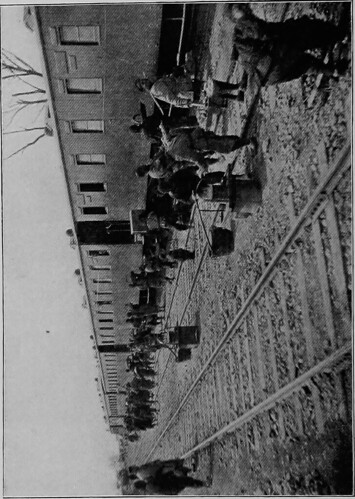
Image by Internet Archive Book Images Identifier: cu31924023226081 Title: An American engineer in China Year: 1900 (1900s) Authors: Parsons, William Barclay, 1859-1932 Subjects: Parsons, William Barclay, 1859-1932 Railroads Publisher: New York, McClure, Phillips & co. Contributing Library: Cornell University Library Digitizing Sponsor: MSN
View Book Page: Book Viewer About This Book: Catalog Entry View All Images: All Images From Book
Click here to view book online to see this illustration in context in a browseable online version of this book.
Text Appearing Before Image: ngle-track lines, exceptthe division between Tien-tsin and Peking. Thetrack is of the American type ; the locomotivesare partly American and partly English; and thecars, both passenger and freight, are an adapta-tion of both the American and English patterns,made to conform with local conditions, and intheir construction to come within the facilities oflocal shops, for all the rolling stock, except theengines, is home-made. As a field for the future, China stands pre-eminent on account of its size, its population, andits well-known but undeveloped mineral wealth,and offers chances and opportunities that are tobe found nowhere else in the Orient. The Japanese, in his essentials, does not differradically from other Eastern Asiatic races. Start-ing from a point much inferior in the way of com-mercial development to that attained by the Chi-nese, he has built up, the greater part by his ownindividual and unassisted efforts, a railway systemthat can take rank with the railways of any other
Text Appearing After Image: J3 o s- ^ V B. Chapter IX: Railways 285 country. What he has done the Chinese can do,and will do, especiall} seeing that the conditionsfor success on the mainland, with possibilities lorthrough traffic and vast mineral deposits await-ing rail transportation outward, exceed those ofinsular Japan. Chapter X The Yellow Peril THERE are two questions in regard toChina that are frequently raised, whichmerit attention on account of their beingsupported by a belief that appears to be quitewide-spread. One is whether it is not dangerouscommercially to supply the Chinese with facto-ries, mills, railways and other modern means ofconstructing, by means of which, operated bytheir cheap labor, they will be able to flood theworld with articles at a price lower than theycan be manufactured elsewhere, and thus closeour own factories, or compel our laborers towork for less pay. The other question is whetherit is not dangerous politically to teach the Chi-nese modern methods, lest they will devote their
Note About Images Please note that these images are extracted from scanned page images that may have been digitally enhanced for readability – coloration and appearance of these illustrations may not perfectly resemble the original work.
1 note
·
View note
Text

i will confirm louise is an aries born on march 21st!! it's a reference to her first comic appearance in firestorm #21 (march 1984) and the fact most of my moots voted she's a aries based on the poll i posted from a couple of months ago ♡
#˗ˏˋ ༄ ──── 𝐇𝐄𝐀𝐃𝐂𝐀𝐍𝐎𝐍𝐒 〳 ❪ violence creates and molds as well ❫#she's going to kill me i missed her bday 😭😭#happy late birthday to the ice queen herself 🎉🎉🎉#my birthday is tomorrow omfg!!#i'm going to watch the p.enguin it's so fucking GOOD
6 notes
·
View notes